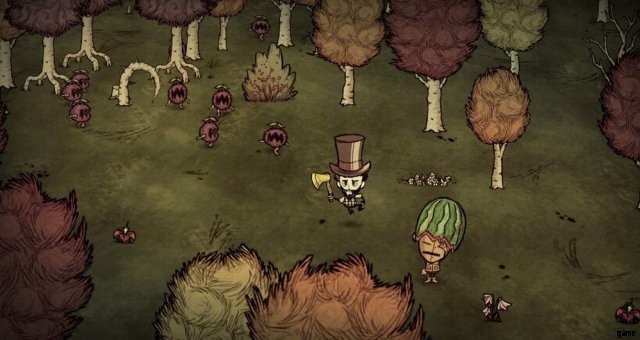
Dieser Leitfaden enthält eine detaillierte Beschreibung aller 20 Biome, die in einer Vanilla-Waldwelt von Don’t Starve Together entstehen können. Die Abdeckung umfasst die Verteilung von Ressourcen, Mechanismen hinter biomspezifischen Vergünstigungen (z. B. Sandstürme, Tumbleweed-Spawner, Meteor-Spawner) und Unterscheidungsmerkmale. Dieser Leitfaden versucht, Details zu ergänzen, die dem Don’t Starve-Wiki derzeit fehlen.
Andere Don’t Starve Together-Leitfäden:
- Anleitung zu den Charakteren.
- Wann und wie Sie Glommer finden.
- The Gorge / Quickstart and Beginners Guide.
- Neue Errungenschaften der Schlucht (Schluchtbeherrschung).
- Spielanleitung:Webber.
- Leitfaden für Twitch-Drops.
Einführung
Dieser Leitfaden soll eine umfassende Referenz für alle Biome sein, die im Wald mit den Standardeinstellungen in „Don’t Starve Together“ generiert werden. Wald bezieht sich auf die Oberflächenwelt; Biome, die in den Höhlen gefunden werden, werden hier nicht diskutiert (und können bei ausreichender Motivation in einem zukünftigen Leitfaden behandelt werden). Die detaillierte Mechanik hinter der Weltgenerierung wird in diesem Handbuch nicht behandelt, einfach weil ich es nicht verstehe und nur sehr wenig Code ausgegraben wurde. Daher enthält der Leitfaden nur Details, die auf dem basieren, was ich beobachten konnte. Ich gehe jedoch mehr ins Detail als das, was das aktuelle Don’t Starve Wiki bietet. Außerdem versuche ich, keine Meinungen oder empfohlenen Strategien/Tipps zu geben (z. B. welches Biom das beste ist, um eine Basis aufzubauen), da jeder Spieler andere Ziele, Fähigkeiten und Spielstile im Auge hat. Stattdessen werde ich Details zu den Ressourcen und Vorteilen bereitstellen, die in jedem Biom verfügbar sind. Es liegt ganz beim Leser, zu entscheiden, wie er sie verwendet.
Definition
Was meine ich mit „Biom“? Das Wiki ist sich nicht ganz sicher, wie der Begriff definiert werden soll. Es scheint, dass ein Biom auf einem einzigen Gelände/Rasen basiert, aber bedeutet dies, dass der Savannenfleck, der in der Dragonfly-Wüste liegt, ein Savannenbiom ist? Was ist mit dem Savannenfleck im Mandrake Forest? Das Problem bei der Definition auf der Grundlage eines einzelnen Terrains/Reviers besteht darin, dass diese alle über die Karte verstreut sind, während einige Reviere nur als Teil einer Standardfigur generiert werden (z. B. das „Schach“-Biom, das die Schachfiguren und alle Varianten enthält). . Es gibt auch den gemischten Rasen im bekannten Mosaik-„Biom“. Wie Sie sehen können, ist diese Definition chaotisch, inkonsistent und unbequem. Der Versuch, Orte in DST zu erklären, ist bereits eine Herausforderung, und verwirrende Biomdefinitionen helfen dabei nicht. Es gibt einen besseren Weg.
„Biom“ in diesem Handbuch ist Folgendes:eine einzigartige Sammlung von Terrain, Ressourcen und Versatzstücken, die zusammen in einer „Don’t Starve Together“-Welt entstehen. Sie können sich jedes Biom als „Raum“ in einem Haus (der Welt) vorstellen, und jeder Raum enthält eine Reihe von „Möbeln“ (die Ressourcen, Versatzstücke und Vergünstigungen), die für ihn einzigartig sind. Die Räume können auf verschiedene Arten angeordnet werden, aber die Räume werden nie auseinander gebrochen und bilden immer zusammen ein zusammenhängendes Stück (hier ganz großes Sternchen – siehe den Abschnitt über sich überschneidende Biome im Anhang). Das Konzept ist weitgehend von T Shaw Killer in seinem Force Biomes-Mod inspiriert und ist am besten visuell in diesem Diagramm zu sehen:
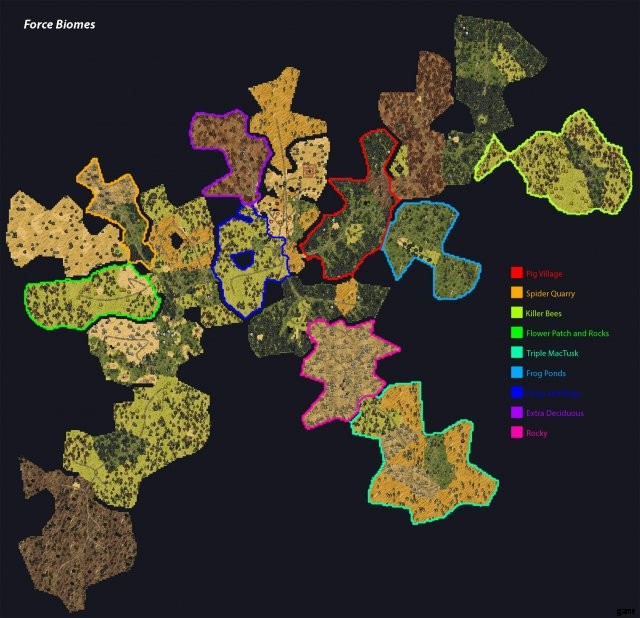
Beachten Sie, dass in diesem Diagramm nur die optional generierten Biome markiert sind, aber das gleiche Konzept gilt für die Biome, die garantiert generiert werden. In gewisser Weise kann diese Anleitung als ergänzende Referenz zu seiner Mod angesehen werden.
Weltgeneration
In der normalen DST-Weltgenerierung versucht das Spiel, eine Waldwelt mit den 10 garantierten Biomen und zufälligen 5 der 10 optionalen Biome (alle unten aufgelistet) zu erstellen.
Benennung
Ein Problem, mit dem man sich auseinandersetzen muss, ist das Fehlen jeglicher „offizieller“ Namen für Biome. Daher habe ich Namen gewählt, die jedes Biom hervorheben und einzigartig machen. Die Namen für die garantierten Biome sind meine Ideen, aber die Namen für die optionalen Biome basieren auf denen von T Shaw Killer.
Format des Leitfadens
Jedes Biom wird wie folgt organisiert:
- Kartenansicht des Bioms.
- Beschreibung – gründliche Diskussion der verfügbaren Ressourcen und ihrer Verteilung.
- Wurmlöcher und Dolinen – ob sie generiert werden oder nicht.
- Grasgecko-Welten – die Veränderungen am Biom, wenn die Welt als Grasgecko-Welt generiert wird.
- Einzigartige Vorteile – bemerkenswerte Objekte, Funktionen und Ereignisse, die nur im Biom vorkommen.
- Ressourcen – Liste der Ressourcen, die natürlich im Biom entstehen (Vögel sind nicht aufgeführt – weitere Informationen finden Sie im Anhang).
- Optionale Versatzstücke – Liste bemerkenswerter Versatzstücke, die auf besagtes Biom oder einige wenige Biome beschränkt sind (z. B. Hochvogelfestungen, Fäulnisfalle) – Liste ist sehr unvollständig.
- Unterscheidungsmerkmale – wie man sie von anderen ähnlichen Biomen unterscheidet.
Versatzstücke
Standardsituationen werden in diesem Leitfaden nur minimal behandelt und vermieden, es sei denn, eine bestimmte Standardsituation wird immer in der Welt generiert. Das Don’t Starve-Wiki ist auch unvollständig, was Versatzstücke angeht, aber das ist ein weiterer Kaninchenbau, in den ich mich im Moment nicht vertiefen möchte.
Bestellung
Die Biome in diesem Leitfaden sind wie folgt in alphabetischer Reihenfolge in zwei große Abschnitte geordnet.
Biome, die garantiert Folgendes erzeugen:
- Bienenkönigin
- Libellenwüste
- Alraunwald
- Mondwald
- Mosaik
- Oasenwüste
- Schweinekönig
- Portal
- Sumpf
- Savanne
Optionale Biome:
- Extra Laub
- Zusätzliche Meteore
- Frösche und Käfer
- Froschteiche
- Killerbiene
- Schweinedorfwald
- Quad Elcheier
- Rockylands
- Spinnensteinbruch
- Triple MacTusk
Mondinsel-Biome
Die neuen Biome im Return of Them-Update sind derzeit nicht in diesem Handbuch enthalten.
Bienenkönigin
Ein typisches Bienenkönigin-Biom:
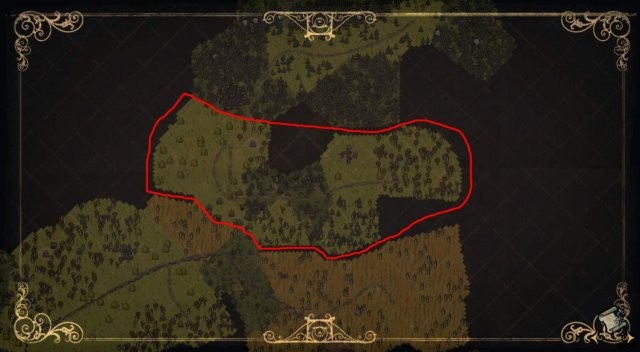
Beschreibung
Das Biom der Bienenkönigin enthält den Riesenbienenstock. Das Biom besteht aus vier verschiedenen Teilen:Bienenfeld, Bienenkönigingebiet, Grasland, Wald. Der Wald erzeugt nicht immer. In diesem Biom befindet sich ein Versatzstück aus einem Elchteich.
Bienenfeld:
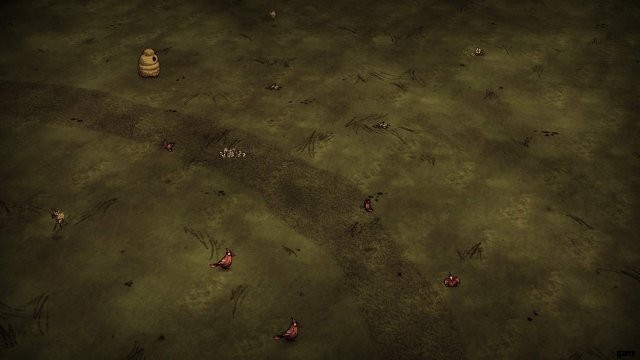
Das Bienenfeld enthält eine spärliche Sammlung von Bienenstöcken und Blumen. Glühwürmchen können in diesem Bereich gefunden werden.
Bereich der Bienenkönigin:
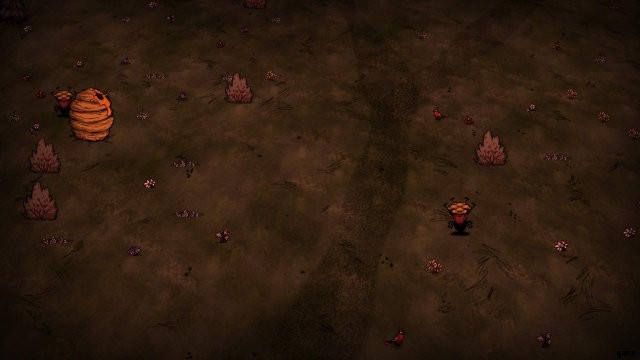
Das Bee Queen-Gebiet umfasst den Giant Beehive, bis zu zwei Killerbienenstöcke und eine dichte Sammlung von Blumen und Beerensträuchern. Normale Bienenstöcke können sich in diesem Bereich bilden, dies ist jedoch nicht garantiert.
Grasland:
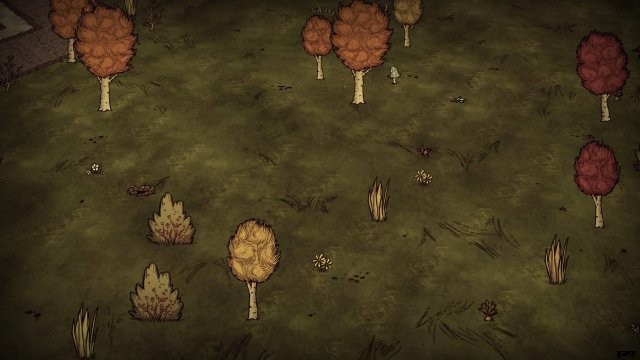
Das Grasland ähnelt dem in den Biomen Portal, Killer Bee, Frogs and Bugs und Triple MacTusk. Dieses Gebiet verfügt über Gras, Setzlinge/zweigige Bäume, Beerensträucher, Blumen, Karotten, Birken, Immergrüne und Feuerstein. Kaninchenlöcher, Maulwurfwurmhöhlen und alle drei Pilze sind hier häufig zu finden, aber sie erscheinen nicht in ausreichender Zahl, um sie immer zu erzeugen. Dasselbe gilt für Spinnenhöhlen, sind aber seltener.
Wald:
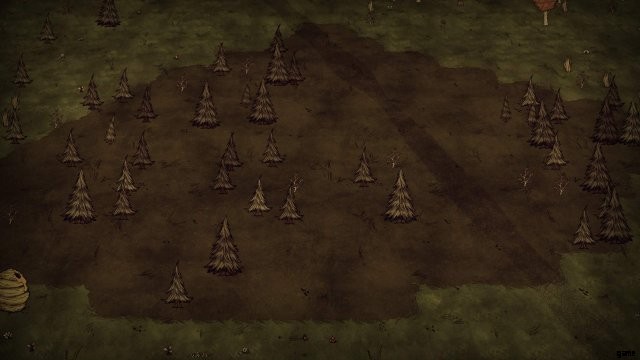
Der Wald wird von immergrünen/klumpigen immergrünen Pflanzen und Setzlingen/Zweigbäumen bevölkert. Glühwürmchen sind hier zu finden, kommen aber häufiger im Bienengebiet vor.
Wurmlöcher und Dolinen
Sowohl Wurmlöcher als auch Dolinen können hier entstehen, aber beides wird garantiert nicht.
Grasgecko-Welten
In einer Grasgecko-Welt fehlt Gras im gesamten Biom. Grasgeckos werden in diesem Biom nicht generiert.
Ressourcen
- Grasbüschel
- Setzlinge oder Zweigbäume
- Flint
- Beerensträucher
- Karotten
- Rote, grüne und blaue Pilze
- Blumen
- Evergreens
- Klumpige Evergreens
- Birkenbäume
- Bienenstöcke
- Killerbienenstöcke
- Kaninchenlöcher
- Maulwurmhöhlen
- Glühwürmchen
- Spinnennester
- Teiche
Bemerkenswerte Vorteile
Das Biom enthält den gigantischen Bienenstock, der gehämmert werden kann, um die Bienenkönigin zu beschwören.
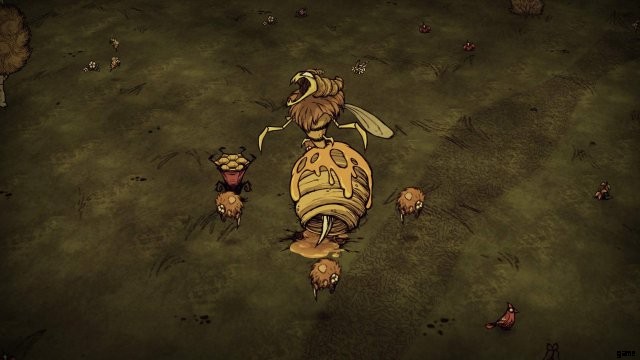
Unterscheidungsmerkmale
Das Bienenkönigin-Biom ist das einzige, das den gigantischen Bienenstock enthält. Das Biom kann auch durch das Vorhandensein von Killerbienenstöcken identifiziert werden, obwohl sie auch im Killerbee-Biom zu finden sind. Das Frogs and Bugs-Biom enthält das gleiche Terrain, aber es fehlt der Wald. Das Portal-Biom sieht auch ähnlich aus, aber es fehlt der Savannenrasen.
Libellenwüste
Ein Libellenwüstenbiom:
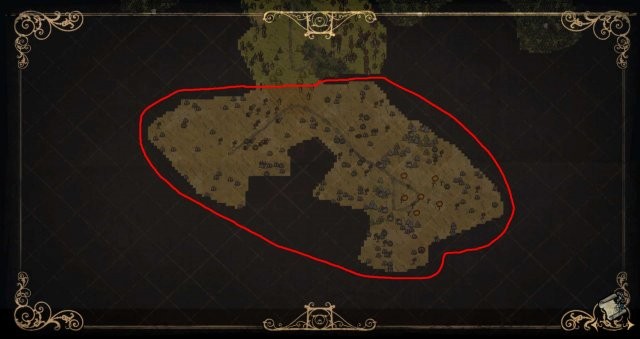
Beschreibung
Die Libellenwüste ist eines der beiden Wüstenbiome und enthält das Versatzstück der Libelle.
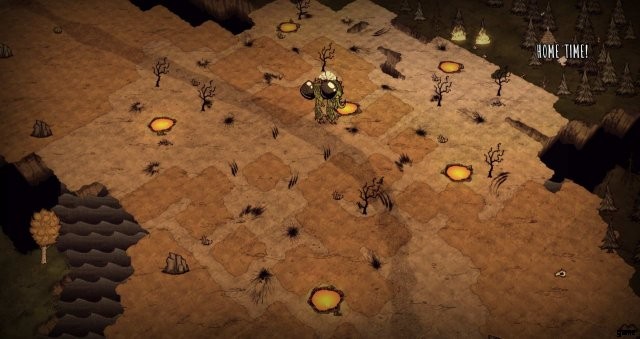
Das Biom ist größtenteils mit Sandrasen bedeckt, rundherum sind leere Rasenflächen verstreut. Das sandige Gebiet enthält den Großteil der Ressourcen, darunter reine Steinbrocken, stachelige Bäume und Büsche, Kakteen und Knochen.

Buzzard-Spawns entstehen als Cluster von bis zu 12 (möglicherweise mehr) und sind häufig entlang der Straße zu finden.
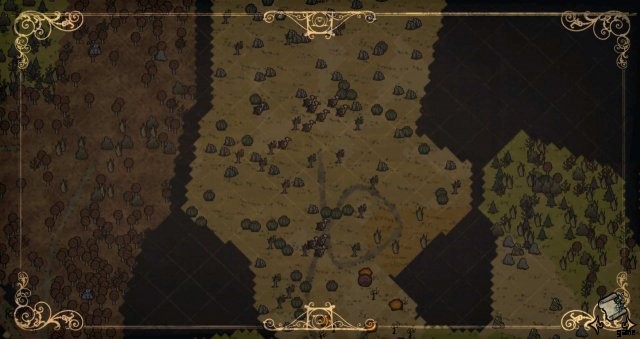
Hundehügel entstehen auch als Cluster und werden von salpeterhaltigen und goldhaltigen Felsbrocken begleitet.
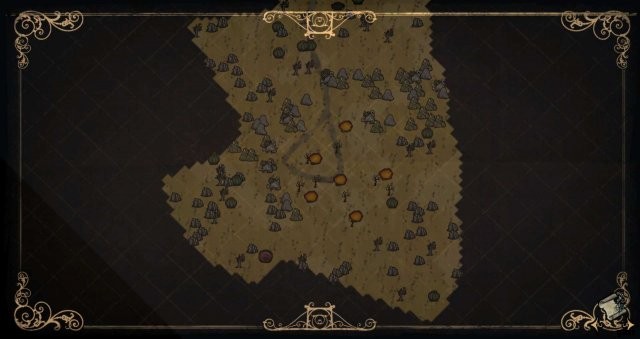
Das Biom enthält auch ein Stück Savannenrasen, das nur Grasbüschel und Kaninchenlöcher enthält.
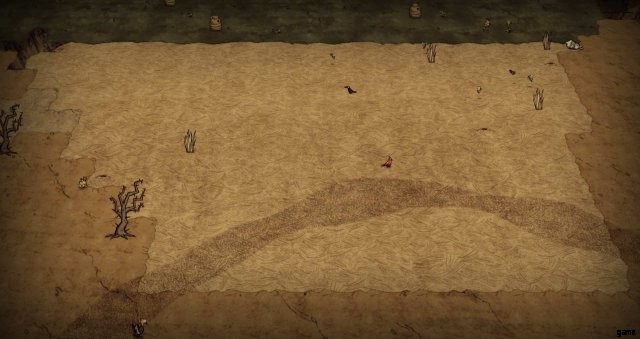
Sowohl die Tallbird- als auch die Hound Mound Fortress-Setteile können in diesem Biom generiert werden. Gelegentlich können klumpige Evergreens entstehen.
Wurmlöcher und Dolinen
Obwohl manchmal Wurmlöcher in diesem Biom entstehen, Dolinen nicht.
Grasgecko-Welten
If it is a Grass Gecko world, Grass Geckos will generate in this biome, and grass tufts will still generate on the savanna turf.
Unique Perks
Tumbleweeds spawn exclusively in this biome, and they do so from multiple invisible spawners scattered over the sandy turf area:
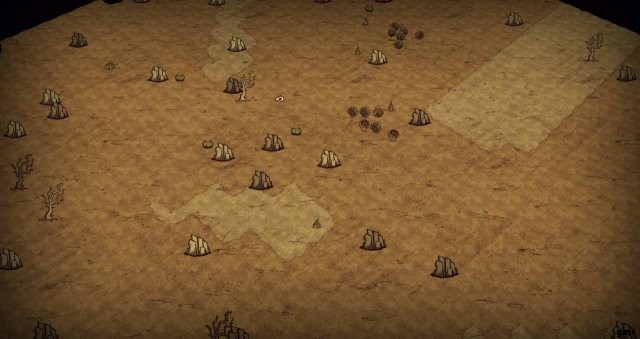
Each spawner produces a single tumbleweed every 0.5 to 3 days, and the max number of tumbleweeds per spawner varies from 4 to 7.
Resources
- Gras
- Tumbleweeds
- Flintless Boulders
- Nitre-bearing Boulders
- Gold-bearing Boulders
- Spiky Trees and Spiky Bushes
- Burned Spiky Trees and Spiky Bushes (as part of the Dragonfly set piece)
- Bones
- Cacti
- Rabbit holes
- Buzzards
- Hound Mounds
Optional Set Pieces
- Hound Mound Fortress
- Tallbird Fortress
Distinguishing Features
The Dragonfly desert can be distinguished from the Oasis in several ways:rounded cacti (as opposed to branching cacti in the Oasis), spiky trees (the oasis lacks these), hound mounds (not as part of the hound mound set piece, which can appear in the oasis), and the savanna patch.
Mandrake Forest
Map view of a mandrake forest:
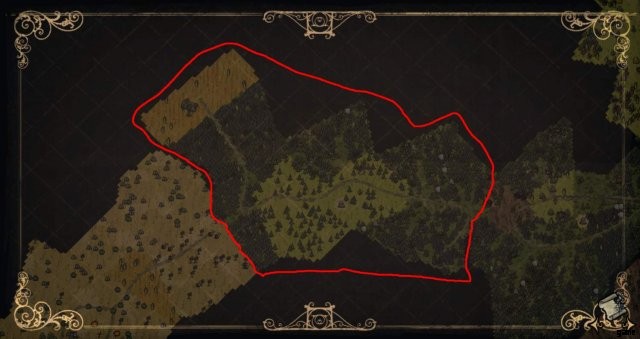
Description
The mandrake forest biome is the one where mandrakes generate in. There are three main parts to the biome:the evergreen forest, the mandrake field, and the beefalo field. Two optional areas can generate here:a dense forest and less dense forest.
The evergreen forest:
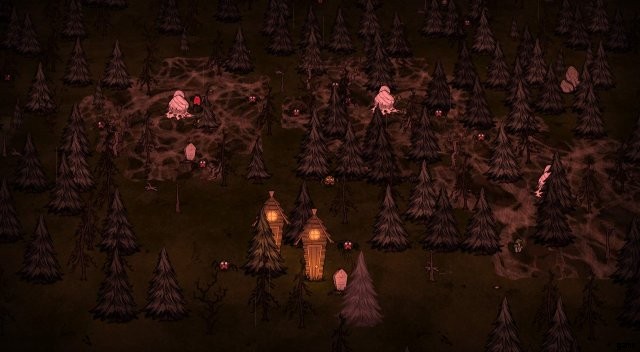
The evergreen forest is the one containing pig houses, spider dens, and graves. This area takes up the bulk of the biome, and is mainly populated by evergreens. Pig houses and spider dens are plenty, and are commonly found together. Saplings/twiggy trees can be found frequently here, while grass does not generate here. Flint-bearing and gold-bearing boulders are very sparse. Red mushrooms and green mushrooms are exclusive to this area of the biome, and are relatively common. Flowers are present, but are less common here compared to the mandrake field. The moose pond set piece generates here, although individual ponds can also be found.
Mandrake field:
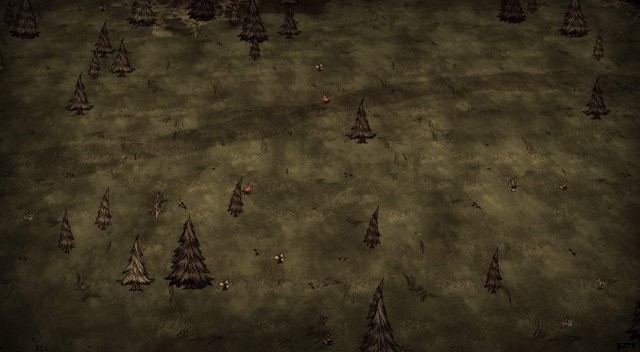
The mandrake field is the area containing up to four mandrakes. Grass tufts can be found here, but are relatively uncommon. Saplings, berry bushes, and flowers generate here while mushrooms do not. Evergreen trees can be found here, but in comparable density to the less dense forest. Fireflies can be found here.
Beefalo field:
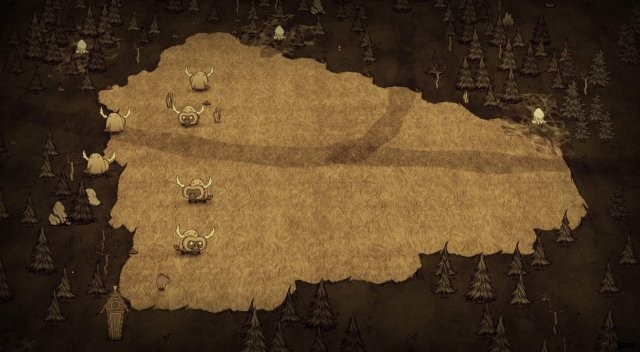
The beefalo field is home to at least a single beefalo herd. Larger beefalo fields can generate with more. Grass can generate here, but are not guaranteed to do so.
Dense forest:
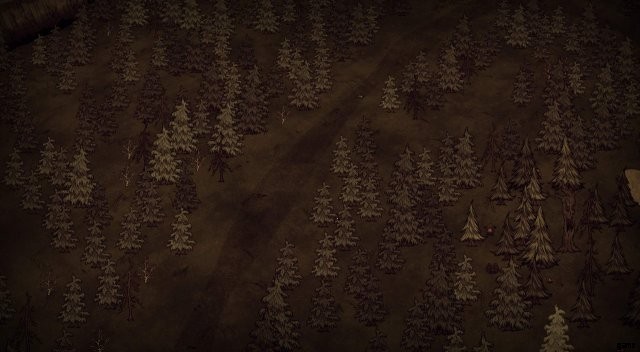
The dense forest contains a slightly denser population of evergreens and lumpy evergreens. Totally Normal Trees have been observed to generate here. Saplings are common here, while grass tufts are few. Blue mushrooms are the only type can be found here, but are rare and not guaranteed to generate. Fireflies can be found here. Flowers are not present, except for the evil varieties near Totally Normal Trees. Berry bushes can be found here, but also quite rare. The dense forest does not always generate.
Less dense forest:

The less dense forest is the area containing relatively few evergreens and lumpy evergreens. This forest can generate with either exclusively evergreens or lumpy evergreens. Saplings/twiggy trees, grass, and fireflies are the only other resources that can be found here. The less dense forest does not always generate.
Wormholes and Sinkholes
Both sinkholes and wormholes can generate in this biome, but neither are guaranteed to do so.
Grass Gecko Worlds
In a grass gecko world, grass is absent from the entire biome including the beefalo field. Grass geckos do not generate here.
Resources
- Gras
- Saplings
- Flint-bearing boulders
- Gold-bearing boulders
- Evergreens
- Lumpy Evergreens
- Berry Bushes
- Flowers
- Totally Normal Trees
- Evil Flowers (near totally normal trees)
- Red, Green, and Blue Mushrooms
- Fireflies
- Spider Dens
- Pig Houses
- Graves
- Frog Ponds
Optional Set Pieces
- Imprisoned Pig
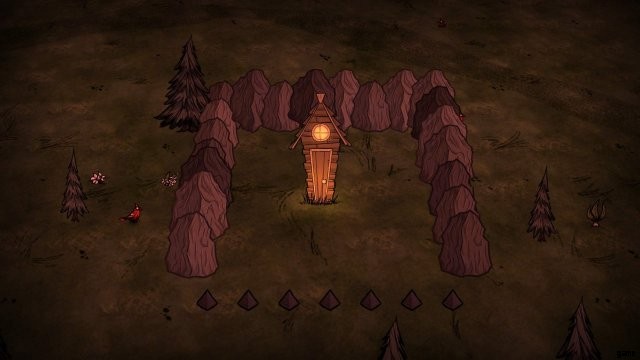
Distinguishing Features
The Mandrake Forest is similar to two other biomes:The Moon Forest, and the Pig Village Forest. An immediate giveaway that it’s a Mandrake Forest is the presence of a Beefalo field, as neither of the other two have the savanna turf-covered area. A Pig Village can be immediately recongized by the presence of marsh turf, while the Moon Forest can be recognized by the presence of Moleworm burrows. If the grassy area in either of these biomes has been found, it is easy to distinguish based on that:If the area contains a walrus camp, it’s a Moon Forest. If pig houses, then it’s a Pig Village. If it has mandrakes, it’s a Mandrake Forest.
Moon Forest
A Moon Forest biome:
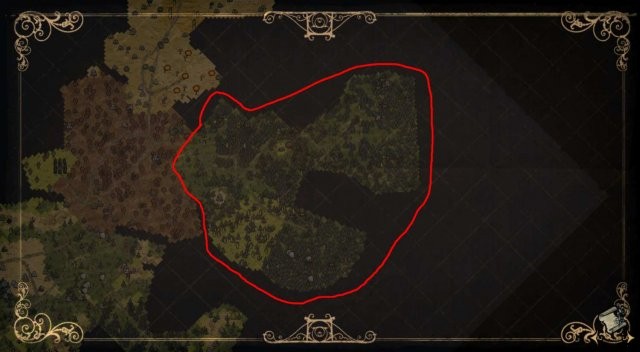
Description
The Moon Forest biome is the one that contains the Moon Stone set piece, and a single walrus camp. A moose pond set piece generates in this biome. The biome consists of the same areas found in the Mandrake Forest, but the beefalo field and mandrake field are replaced by the Moon Stone area, MacTusk field, and moleworm forest.
Moon Stone area:
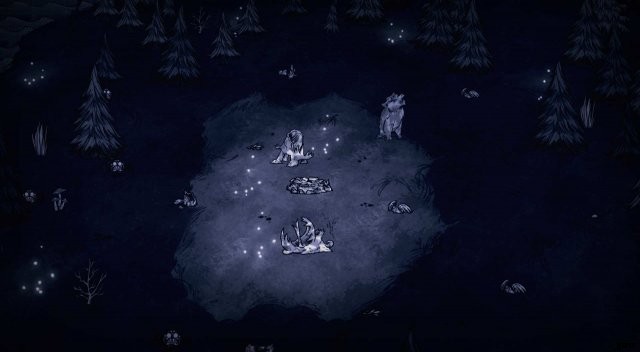
The Moon Stone area contains evergreens, saplings/twiggy trees, fireflies, and the Moon Stone set piece. Two green mushrooms reliably generate around the moon stone. Grass can generate here, but is not guaranteed to do so.
MacTusk field:
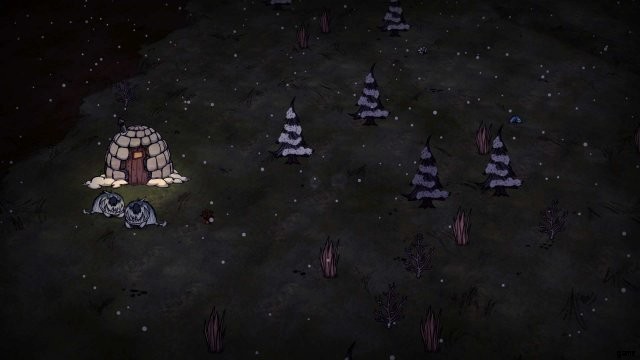
The MacTusk field is home to a single Walrus Camp. Evergreens, saplings/twiggy trees, grass, flowers, carrots, and flint can be found here.
Moleworm forest:
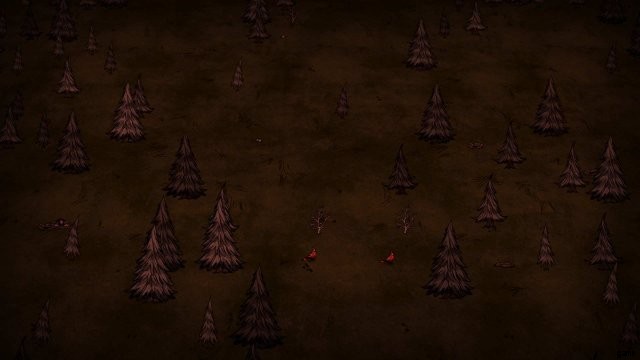
The moleworm forest consists of a collection of moleworm burrows within a slightly less dense collection of evergreens/lumpy evergreens and saplings/twiggy trees. Red mushrooms are few, and are not guaranteed to generate here. Fireflies can be found here. The moleworm forest does not always generate.
Wormholes and Sinkholes
Wormholes and Sinkholes can generate in this biome, but not always.
Grass Gecko World
In a Grass Gecko world, the grass tufts are completely absent from the entire biome. Geckos do not generate in this biome.
Unique Perks
The Moon Stone is a repairable structure that can be used to convert a Star Caller’s Staff into a Moon Caller’s Staff during a full moon.
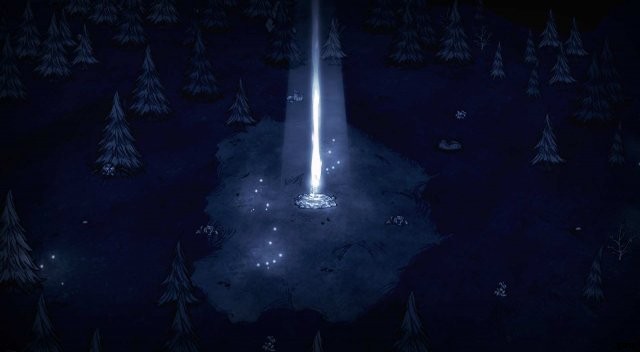
Upon starting the conversion process, any suspicious moonrocks present around the moon stone will reanimate. Completely intact moonrocks will reanimate the hounds/werepigs. Partially broken ones will result in creatures that are instantly killed upon reanimation, and they drop their normal loot.
The conversion takes a little under 1 minute to complete (just under two day segments). Additional hounds and werepigs will spawn when there are less than 6 total, and they will converge on the Moon Stone to stop the process. When the process ends (with the conversion succeeding or failing), all hounds and werepigs still alive will be converted to suspicious moonrocks.
The walrus camp is only active during the winter. The igloo generates at the start of winter when players are outside rendering distance of the camp. Each MacTusk member will respawn every 2.5 after they are killed.
Resources
- Gras
- Saplings/Twiggy Trees
- Berry Bushes
- Nitre-bearing Boulders
- Gold-bearing Boulders
- Flint
- Red, Green, and Blue Mushrooms
- Flowers
- Evergreens
- Lumpy Evergreens
- Pig Houses
- Spider Dens
- Moleworm Burrows
- Fireflies
- Graves
- Totally Normal Trees
- Ponds
Optional Set Pieces
- Spider Trap
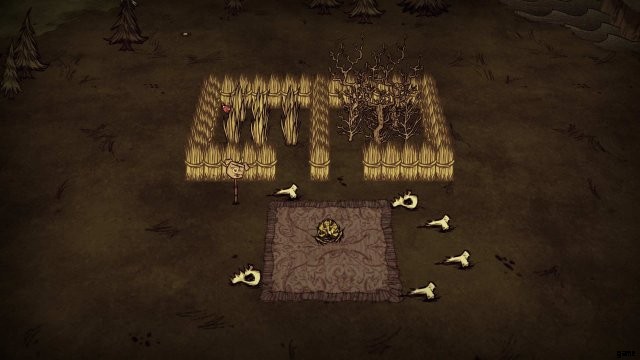
- Queen’s Gathering

Distinguishing Features
The Moon Stone biome can be distinguished from the Mandrake Forest and Pig Village biomes by the presence of moleworm burrows.
Mosaic
Map view of a mosaic biome:
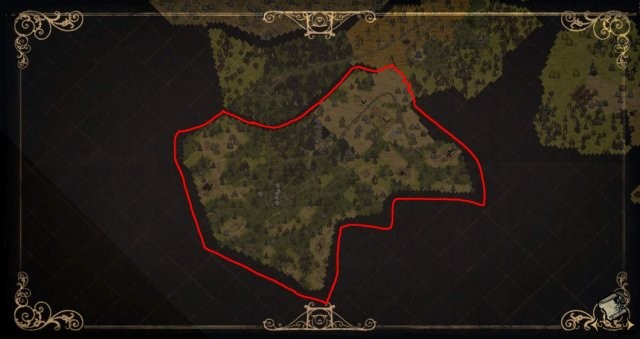
Description
The Mosaic Biome is the biome that contains its characteristic patchwork terrain. There are also three more distinct areas in the biome:the graveyard, the meteor field, and the area around the rock den.
The mosaic terrain:

The mosaic terrain makes up the bulk of the biome. It consists of a mix of grass, forest, marsh, rocky and (unique to this biome) cobblestones turf. Nitre-bearing and gold-bearing boulders are common in this area, but in lower density compared to the meteor field in this biome. Rocks and flint can be found here. Saplings/twiggy trees are fairly common, while grass and berry bushes are sparse. All three mushroom types grow here, but they are also fairly sparse. Moleworm burrows can be found here, while rabbit holes are fewer.
The rock den area:
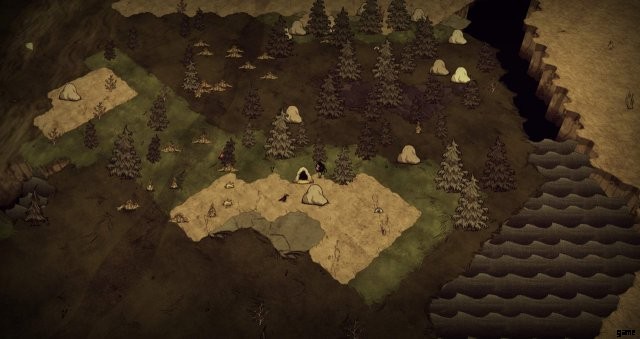
The rock den area contains the rock den, which allows players to “craft” pets. The den is commonly surrounded by a dense collection of evergreens, saplings, and boulders. In a grass gecko world, a large population (about 30) of grass geckos will spawn in this area.
The graveyard:
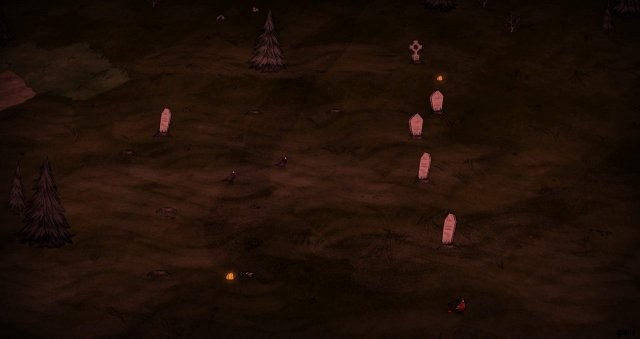
The graveyard area is a patch of forest turf that contains a collection of graves and gold.
The meteor field in the mosaic biome:
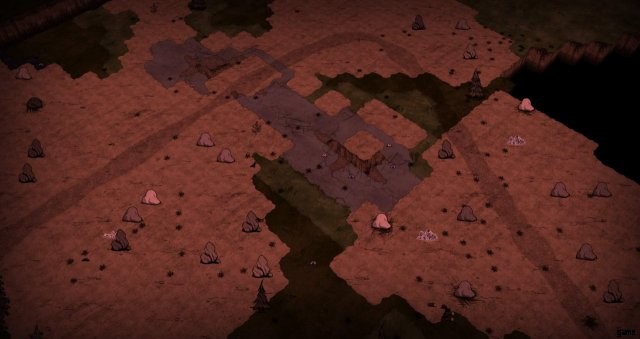
The meteor field is the area marked by bare found (no turf), and is densely populated by nitre-bearing and gold-bearing boulders. Moon rock-bearing boulders can generate here, but not always. Meteor showers occur in this area, and meteors have a chance of leaving behind rocks, flint, moon rocks, flintless boulders, and moon-rock bearing boulders. In a world that generates with the extra meteor zone, the Suspicious Boulder may spawn there instead. Individual Tallbird nests can generate here, but are not guaranteed to do so.
Grass Gecko Worlds
In a grass gecko world, grass is absent from this biome. Grass geckos generate in the rock den area, and the meteor field.
Wormholes and Sinkholes
Wormholes and sinkholes can generate in this biome, but neither are guaranteed to do so.
Unique Perks
The mosaic biome is the only home of the rock den, which provides access to pets and the only way to abandon them.
Meteor showers are caused by invisible meteor spawners scattered throughout the meteor field area. The time between every meteor shower is highly variable. For each spawner, meteor showers can occur every 2-20 days.
For every meteor spawn attempt, there is a 60% chance for a small meteor, 20% for a medium meteor, and 20% for a large meteor. Small meteors drop nothing. Medium meteors drop rocks, flint, or moon rocks. For large meteors, there is a 70% chance to spawn a flint-bearing boulder, 15% for a rock-only boulder, and 15% for a moon rock boulder.
For every moon rock boulder that spawns, there is a chance that the Suspicious Boulder spawns instead. The chance begins at 0%, and increases by 34% for every moon rock boulder spawned. Thus, if 3 moon rock boulders have spawned, the chance for a Suspicious Boulder to spawn in the next meteor shower is 100%. If the world is older than 60 days, the chance of spawning the Suspicious Boulder becomes 100% regardless.
Resources
- Gras
- Saplings/Twiggy Trees
- Berry Bushes
- Nitre-bearing Boulders
- Flintless Boulders (from meteor showers only)
- Gold-bearing Boulders
- Moon Rock Boulders (world generation and meteor showers)
- Rocks
- Flint
- Evergreens
- Lumpy Evergreens
- Red Mushroom, Green, and Blue Mushrooms
- Rabbit Holes
- Moleworm Burrows
- Tallbird Nests
Location
The mosaic biome is always adjacent to the portal biome.
Distinguishing Features
Apart from the meteor field, all areas of the mosaic biome are unique to it. The mosaic is the only place that contains patchwork terrain, a fog-permeated graveyard, and the rock den.
Oasis Desert
Map view of the oasis desert:
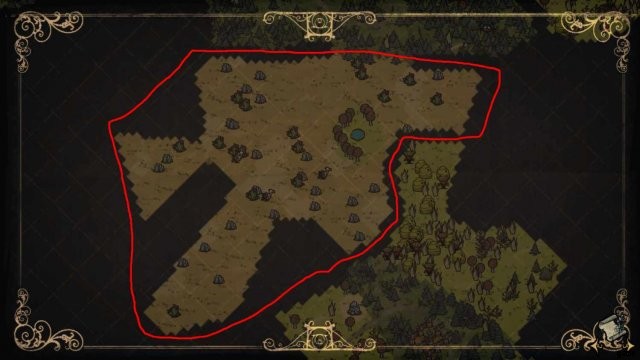
Description
The oasis desert is the biome containing the Lake and the Antlion. The biome is very homogeneous, and only the presence of set pieces interrupt the otherwise typical desert environment. These include the eponymous oasis set piece that always generates in the biome, and optional ones including the hound or tall bird fortresses.
The oasis set piece:
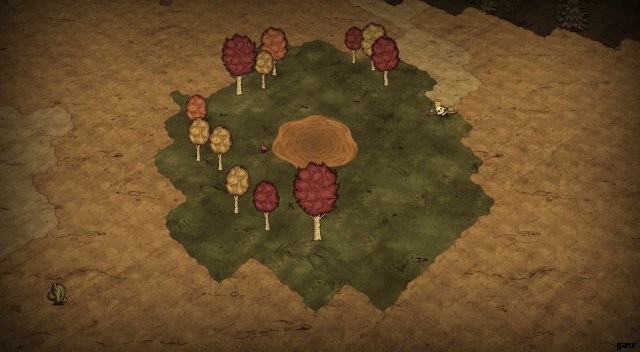
The oasis set piece contains the Lake, which fills up with water only during the summer sandstorms.
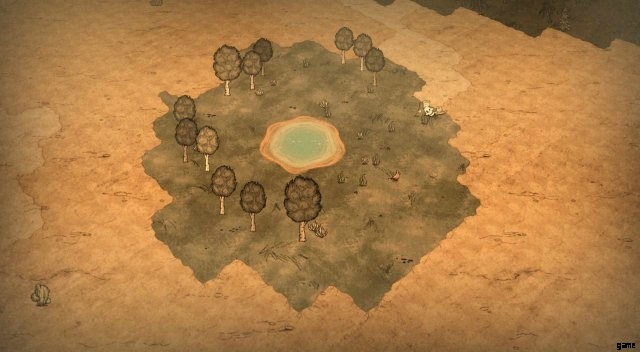
The set piece also features a set of 10 birchnut trees, and a skeleton with straw hat, straw roll, and fishing rod. The entire set piece generates consistently in the same orientation; the screenshot above shows the oasis as it appears with north up. At the start of every summer sandstorm, a set of three fireflies spawn above the Lake if none are present. The set piece is the only area in the biome where the blinding effects of the sandstorm are minimal and the walking speed reduction is not applied.
The desert:
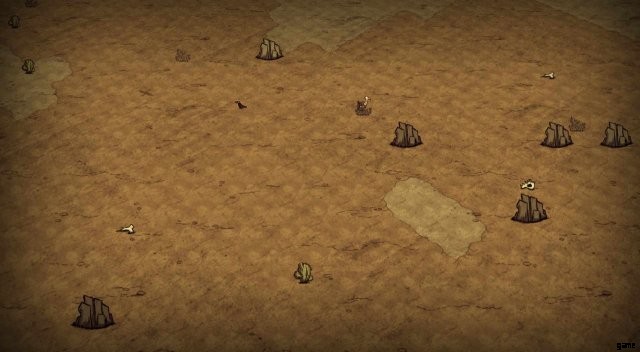
The bulk of the biome consists of desert terrain, which is home to cacti, flintless boulders, bones, buzzards, and volt goats. Spiky bushes are present, but the trees are not. The Antlion appears at a consistent unmarked spot in this area every summer only when a sandstorm is raging.
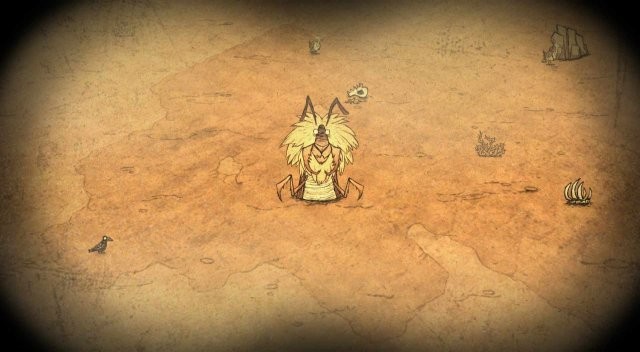
Grass Gecko Worlds
Grass geckos do not spawn here in a grass gecko world.
Wormholes and Snkholes
Wormholes and sinkholes do not generate here.
Unique Perks
Wildfires do not occur within the entire Oasis desert biome while the sandstorm is active. However, crops will still wither if not regularly “irrigated” by an Ice Flingomatic.
With a few days delay, a sandstorm begins raging throughout the biome after the start of summer, and persists until the beginning of autumn. While outside the oasis set piece, movement speed and visibility is greatly reduced:

The effects of the sandstorm can be mitigated by wearing Desert Goggles:
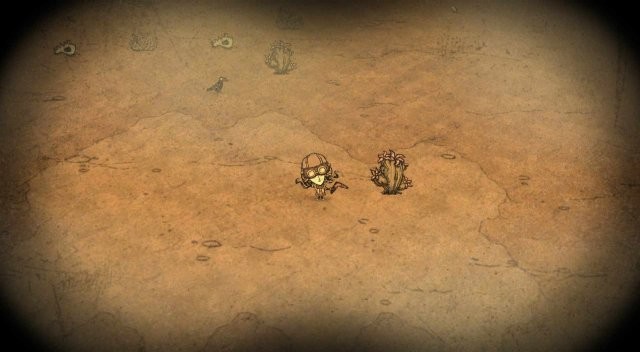
The Antlion is only present when the sandstorm is raging. If rain begins, the sandstorm will stop and the Antlion will disappear for the duration of the storm. If the rain ends before the end of summer, the sandstorm and the Antlion will return.
The Lake can be fished for crumpled packages, which contain the following loot:
- Hardened Rubber Bung
- Gord’s Knot
- Melty Marbles
- Mismatched Buttons
- Potato Cup
- Beach Toy
- Fashion Goggles Blueprint
- Desert Goggles Blueprint
- Potted Succulent Blueprint
- During Winter’s Feast Event only:
- Festive Baubles
- Festive Lights
The Lake is also the only renewable source of fireflies.
Volt goats exclusively spawn in this biome as at least 1 herd.
The Antlion is the source of periodic summer events, which manifest as sinkholes (not to be confused with the cave holes of the same name) at the surface:
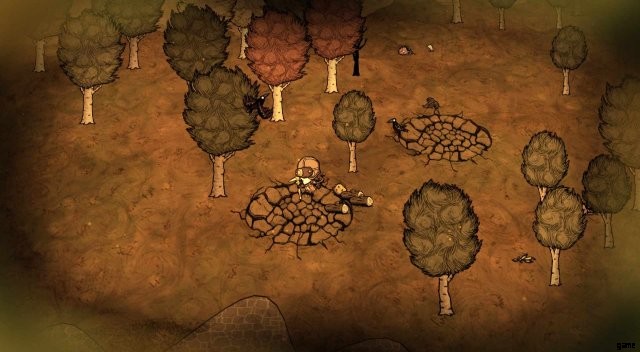
And as cave-ins when in the caves.
It can be given rocks, cut stone, trinkets, or even meat (not including monster meat) in order to delay his periodic attacks up to a cap of 6 days (details about this mechanic are available in the Don’t Starve wiki). When given trinkets or meat, the Antlion will return a desert stone. When given a beach toy, it will return a Lazy Deserter blueprint instead. If given rocks or cut stone, the Antlion will return nothing.
The Antlion can also be fought after being given an orange hot, red hot, or freezing thermal stone.


Resources
- Stone-only boulders
- Spiky Bushes
- Bones
- Cacti
- Succulents (only spawn in summer)
- Birchnut Trees (do not regenerate as part of world regrowth)
Location
The Oasis is never found adjacent to the Portal or Mosaic biomes. If a Spider Quarry exists in the world, the Oasis will almost always be adjacent to it.
Distinguishing Features
The Oasis Desert can be easily distinguished from the Dragonfly Desert by the appearance of the cacti:
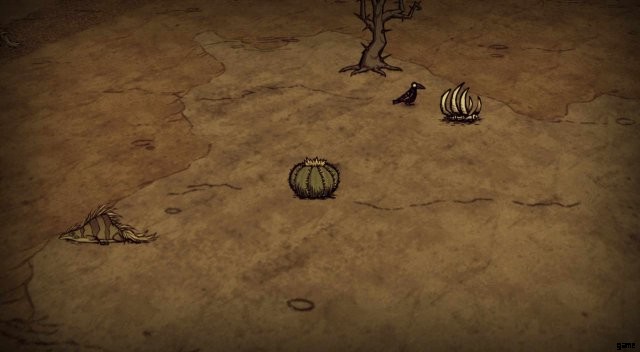
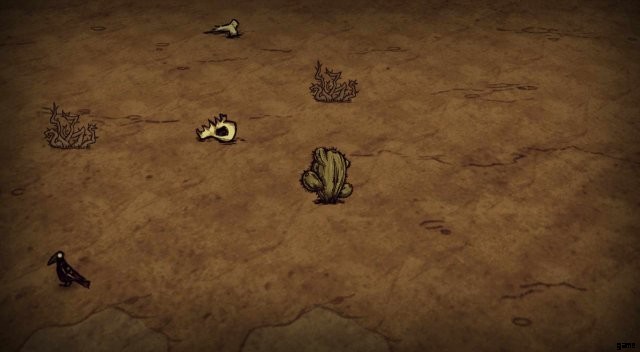
The biome also lacks the spiky trees that are common in the DF desert, and the grass geckos that generate there in a grass gecko world. The oasis desert also does not contain a savanna patch. In the case where both deserts are adjacent to each other, the presence of the sandstorm can be used to mark the boundary between the two biomes.
Pig King Biome
Map view of a Pig King biome:
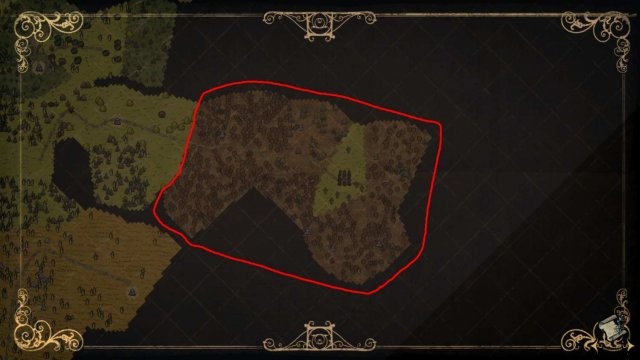
Description
The Pig King biome is the one that contains the Pig King and the Glommer Statue. It is also one of the three biomes where the Loot Stash and No-Eyed Deer can be found during winter (the other two being the Mosaic and Extra Deciduous biomes). The biome includes a moose pond set piece.
The Pig King area:
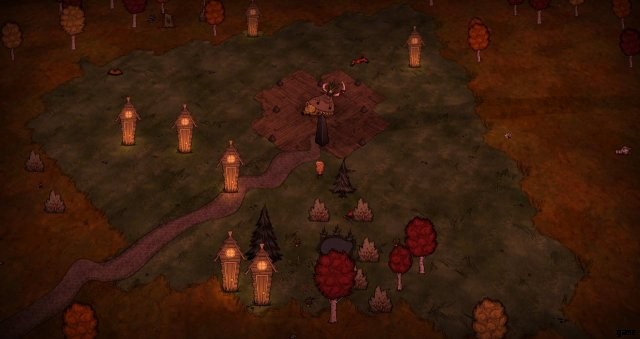
The Pig King area is marked by grass turf and contains the Pig King set piece. Additionally, 6-8 Pig Houses can be found here. A few optional set pieces can generate here, which are typically sets of 15 grass tufts, berry bushes, carrots, or flowers. During the Hallowed Nights event, a set of 15 pumpkins may also spawn here, with Pumpkin Lanterns scattered around. The only other set piece that can generate here is the moose pond set piece.
The Glommer Statue area:

The Glommer Statue area contains the Glommer Statue set piece.
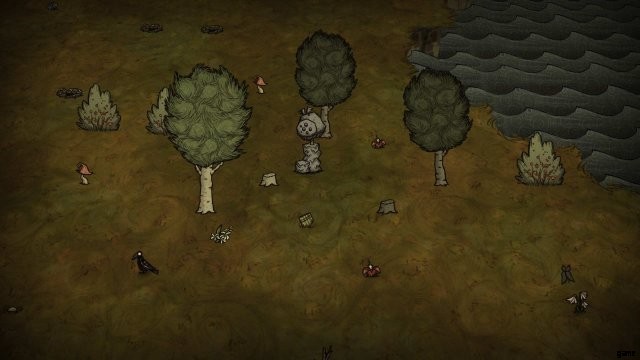
The rest of the area is notably devoid of birchnut trees, and contains flowers, and berry bushes. All three mushroom types can be found here. This is also the only area in this biome where moleworm burrows are found.
The forest area:
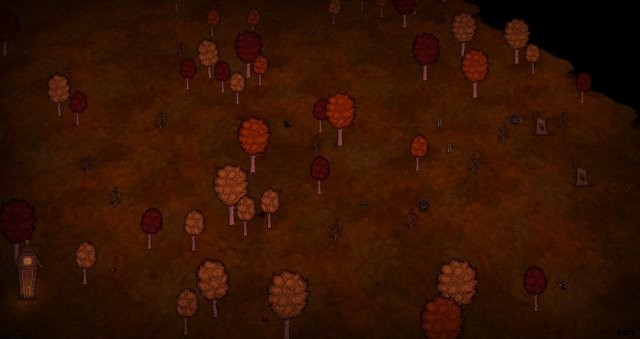
The forest area takes up the bulk of the entire biome, and contains mostly birchnut trees and saplings/twiggy trees. Flowers are common, but carrots are few. Grass tufts can be found here but are very sparse. All three types of mushrooms can be found here, but in lower density compared to the Glommer Statue area. Hollowed stumps (which spawn catcoons) and pig houses are not too uncommon. The No-Eyed Deer and/or Loot Stash have a chance of appearing in this area. Fireflies are very common:

The marble sculpture set piece that always generates in a world can be found here.
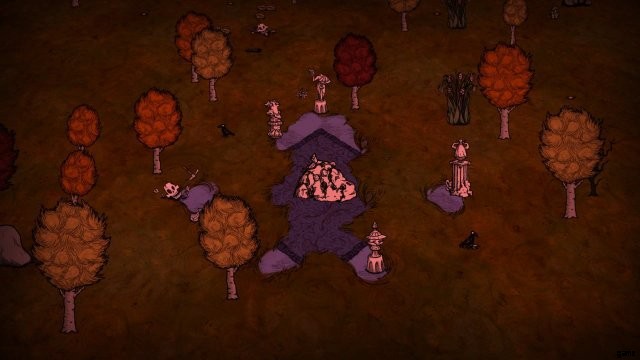
Wormholes and Sinkholes
Both wormholes and sinkholes can generate here, but not always.
Grass Gecko Worlds
In a grass gecko world, grass tufts are absent in this biome. Grass geckos are not found in this biome.
Unique Perks
Glommer’s Statue only spawns Glommer’s Flower at the start of night under a full moon.
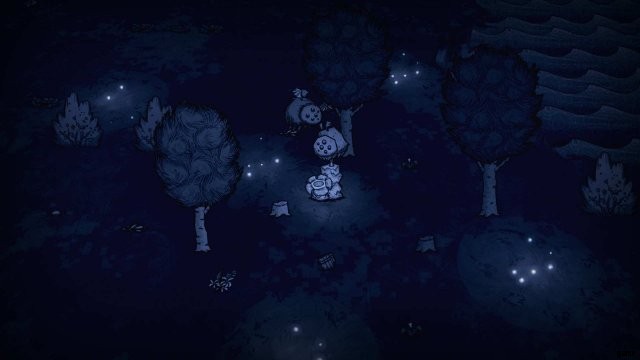
Unless picked, the flower will despawn at the beginning of the next day, and Glommer will fly away only to reappear during the next full moon 20 days later. The statue will not spawn a second flower if a previously acquired Glommer is still alive in the world. It will also not spawn a flower if Glommer is killed at night during a full moon.
The Pig King can be traded trinkets, some meat food, and fur items (pig skin,slurper pelts, bunny puffs) for gold. The Don’t Starve wiki lists the exchange rates.
Resources
- Saplings/Twiggy Trees
- Grass tufts
- Berry Bushes
- Flowers
- Carrots
- Birchnut Trees
- Evergreens
- Red, green, and blue mushrooms
- Hollow Stumps
- Pig Houses
- Moleworm Burrows
Location
If the Pig Village biome is present, it will be connected to the Pig King via cobblestone road.
Distinguishing Features
The forest in the PK biome is nearly identical to that of the Extra Deciduous. There are two ways to identify the Pig King biome:
- The moose pond set piece generates in the Pig King biome, but not the Extra Deciduous.
- In the Pig King biome, the moleworm burrows are found within an open area (the Glommer Statue area), whereas they are found within the deciduous forest in an Extra Deciduous.
Portal
Map view of the portal biome:
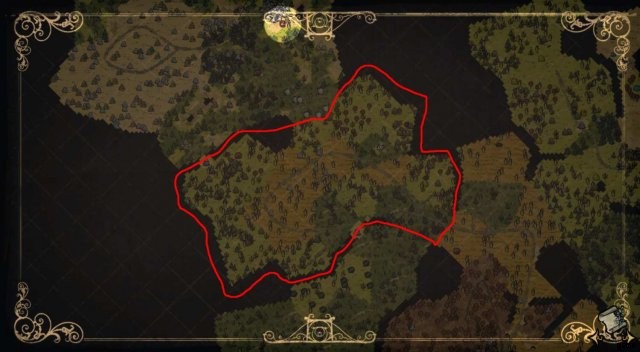
Description
The portal biome is the one that contains the Florid Postern. It contains three distinct areas marked conveniently by their turf:grasslands, savanna, and forest.
The grasslands area:
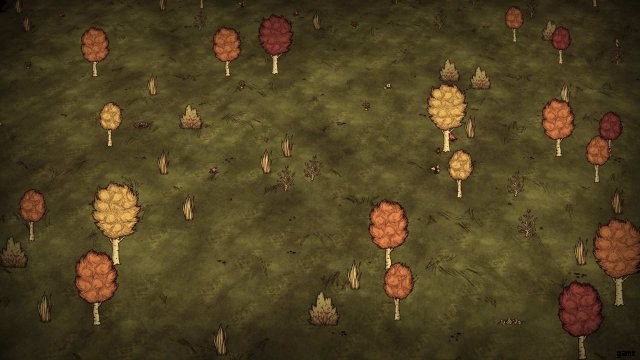
This area of the biome contains saplings/twiggy trees, grass, flint, evergreens, birchnut trees, berry bushes, carrots, and flowers. Red, green, and blue mushrooms grow here, but not many. Rabbit holes are more common in the parts dominated by evergreens, while moleworm burrows are more common in the birchnut domininated ones. Bee hives can generate here, but sparsely so. Ponds generate individually and as part of the moose pond set piece. Spider dens may generate in this area, but not always.
The savanna area:
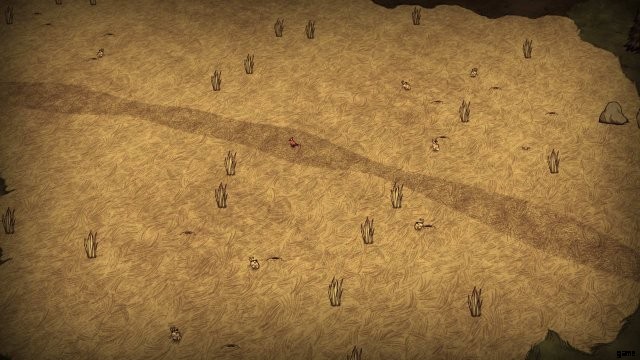
The savanna area is home to numerous rabbit holes and grass tufts, but few green mushrooms and nitre-bearing boulders.
The forest area:

The forest area is populated by saplings/twiggy trees, evergreens, and lumpy evergreens. This is also the only area in the biome where fireflies can be found. Red and Green mushrooms grow in this area, but not many. Grass and berry bushes are also relatively rare. A pig house may generate here, but not always.
Grass Gecko Worlds
In a grass gecko world, all the grass tufts in the grassland and forest area will be absent, and the only grass available will be in the savanna area. Grass Geckos do not generate in this biome.
Sinkholes and Wormholes
Both sinkholes and wormholes can generate in this biome, but not always.
Resources
- Grass Tufts
- Saplings and Twiggy Trees
- Flint
- Berry Bushes
- Carrots
- Flowers
- Red, Green, and Blue Mushrooms
- Evergreens
- Lumpy Evergreens
- Nitre-bearing Boulders
- Rabbit Holes
- Moleworm Burrows
Location
The portal biome is always the first biome to encounter upon entering the world. The mosaic biome is always connected to this biome.
Swamp
Map view of a swamp biome:
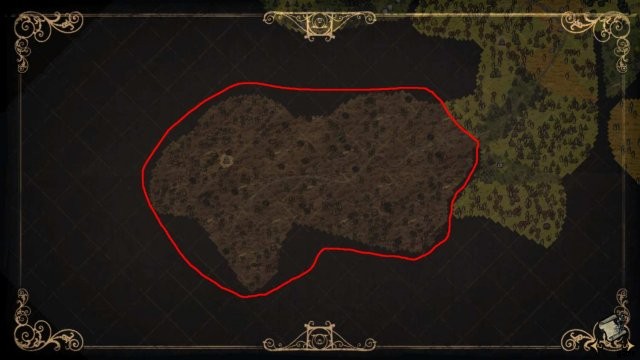
Description
The swamp biome is the one that is covered in marsh turf. Although seemingly homogeneous, it contains two distinct areas:forest area, and reed field. Both areas are home to numerous tentacles. Ponds in this biome spawn mosquitoes during dusk and night.
Reed field:
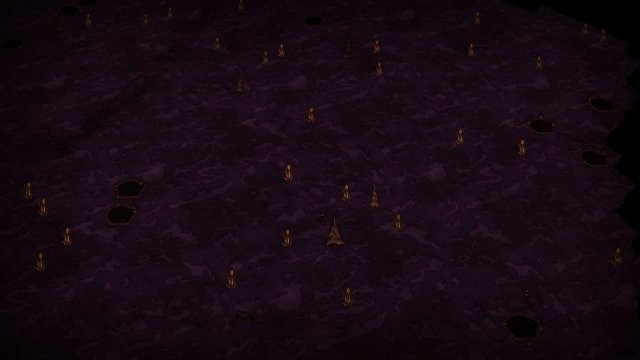
The reed field contains the majority of the reeds in the biome, and a relatively sparse collection of ponds and evergreen trees. This area is commonly found along the road.
Forest area:
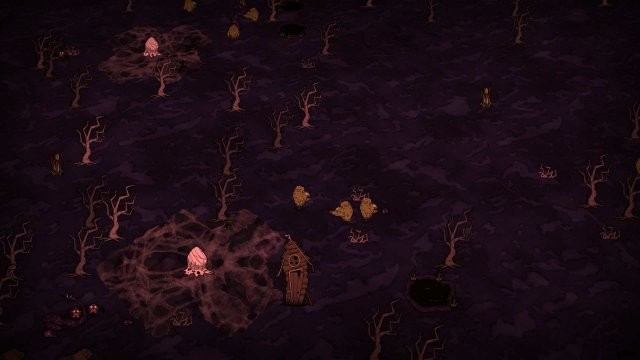
The forest area contains spiky trees, spiky bushes, rundown houses and spider dens. Reeds can be found here, but in lower numbers compared to the reed field. Ponds can be found here as well. This area tends to form along the perimeter of the biome.
Wormholes and Sinkholes
Wormholes can be generated here, but not always. A sinkhole is guaranteed to be generated in this biome.
Grass Gecko Worlds
There are no differences in this biome in a grass gecko world.
Unique Perks
The swamp biome is the only one that contains the optional Reed Trap set piece.
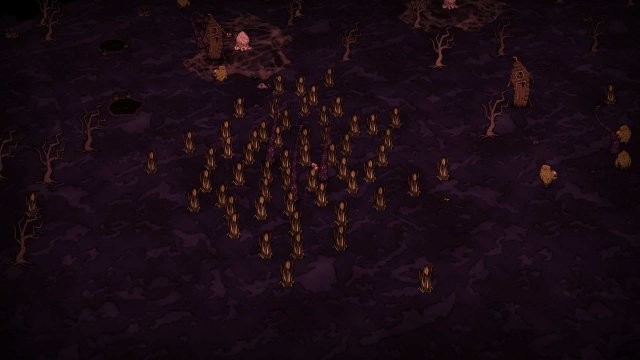
The rot trap set piece can also be exclusively found here.
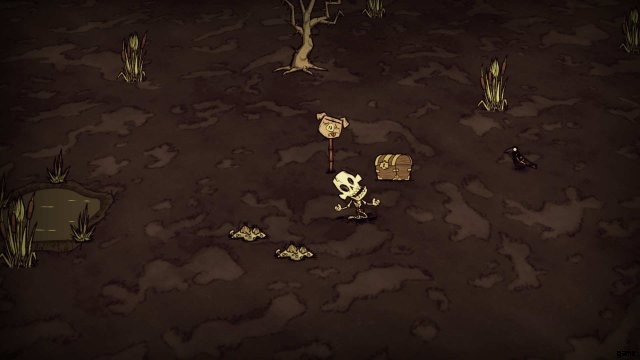
The biome is also the only one where pig heads can be found that are not part of a set piece. They are commonly found on or near the road, but are not guaranteed to generate.
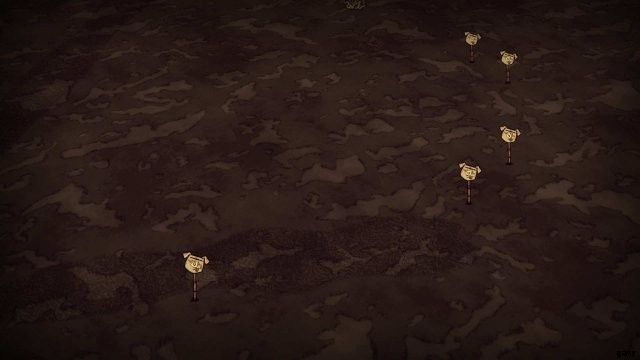
Resources
- Reeds
- Spiky Trees and Spiky Bushes
- Evergreens
- Rundown Houses
- Spider Dens
- Tentacles
- Pig Heads
Optional Set Pieces
- Reed Trap
- Rot Trap
Distinguishing Features
The swamp biome is the only one to contain spiky trees and bushes over marsh turf. The Pig Village biome has an area identical to the reed field, and lacks the spiky trees and bushes.
Savanna
A typical savanna biome:
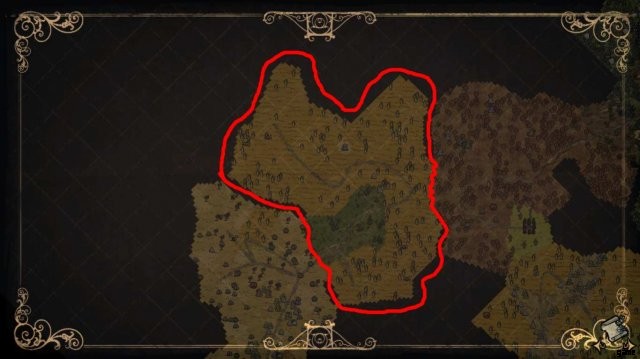
Description
The savanna is the biome that is largely covered with savanna turf. There are three distinct areas:rabbit field, beefalo field, and the barren forest.
Rabbit field:
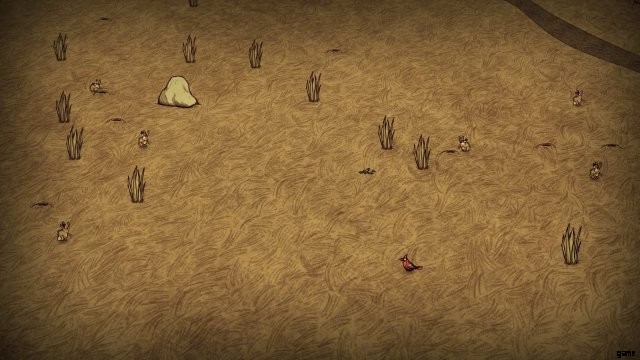
The rabbit field takes up the majority of the biome, and contains the highest concentration of grass tufts found here. Rabbit holes are numerous, while nitre-bearing boulders and flowers are few. Green mushrooms can be found here, but not always.
Beefalo field:
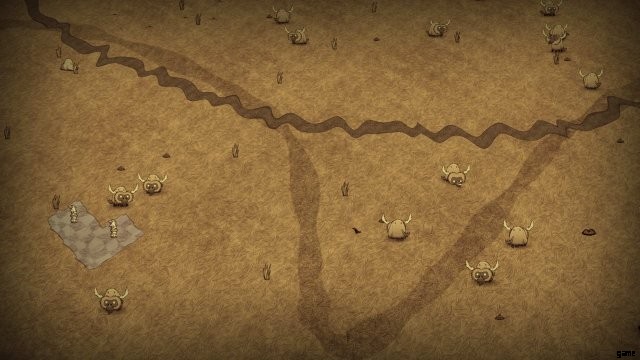
The beefalo field is home to at least one beefalo herd. The only other resource are grass tufts, which can be found here in lower density.
Barren forest:
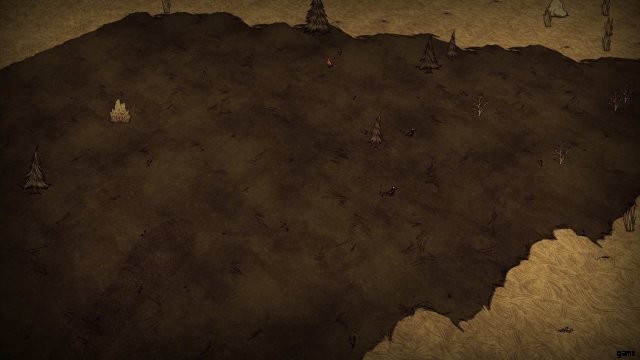
The barren forest is a relatively empty area covered in forest turf. The only resources found here are evergreens, saplings/twiggy trees, berry bushes, red mushrooms, and fireflies. Bee hives, pig houses, and grass can generate here, but not always.
Wormholes and Sinkholes
Both wormholes and sinkholes can generate in this biome, but not always.
Grass Gecko Worlds
In a grass gecko world, the grass in the beefalo field are absent. Grass generates normally in the rabbit field. Grass geckos do not generate in this biome.
Resources
- Grass Tufts
- Saplings/Twiggy Trees
- Berry Bushes
- Red Mushrooms
- Green Mushrooms
- Nitre-bearing boulders
- Flowers
- Rabbit Holes
- Beehives
- Pig Houses
- Beefalo
- Fireflies
Optional Set Pieces
- Beefalo Pen
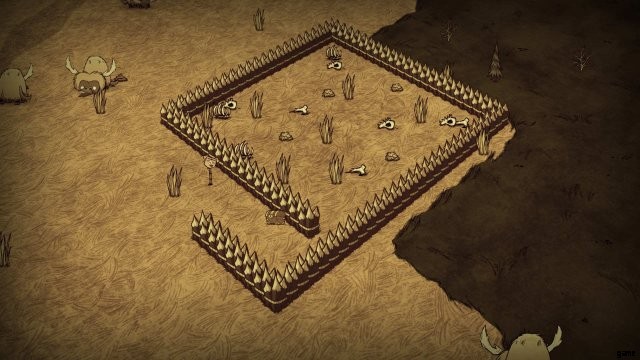
- Guardian Pig – Grass
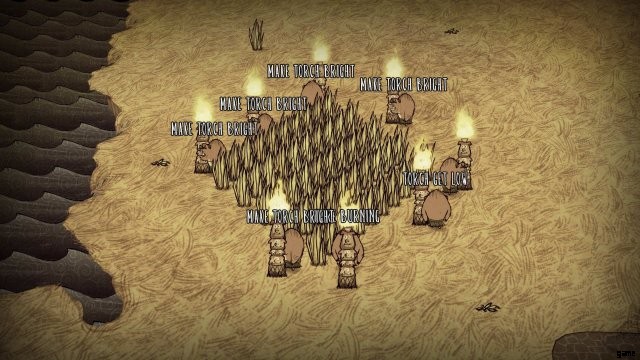
Distinguishing Features
The savanna is similar to the Triple MacTusk biome, but lacks the additional rocky and grass turf.
Extra Deciduous
Map view of an Extra Deciduous biome:
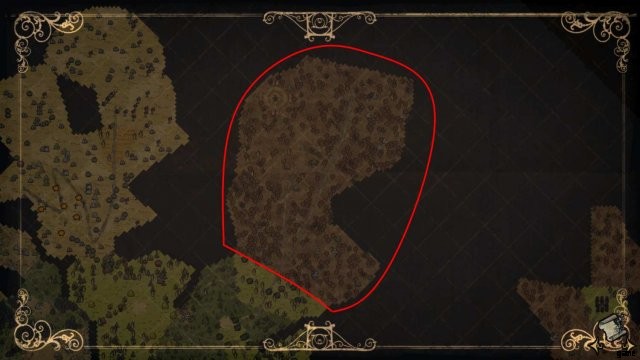
Description
The Extra Deciduous is the optional biome that contains a deciduous forest. The biome appears largely homogeneous, and is nearly identical to the Pig King biome’s forest area.
The forest:
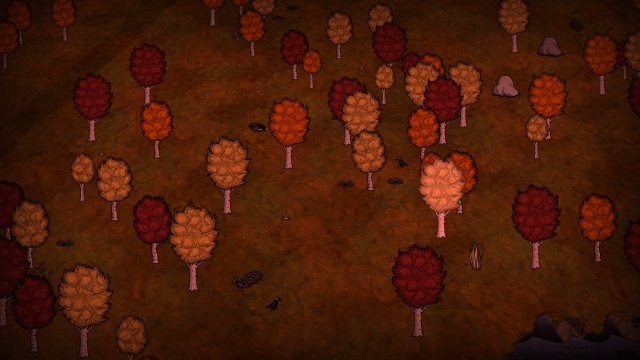
The forest contains exclusively birchnut trees. Saplings/twiggy trees and all three types of mushrooms are commonly found here. Grass tufts, berry bushes, flowers, nitre-bearing boulders, and gold-bearing boulders are not as common. Hollow Stumps and Pig Houses are few. Unlike the Pig King forest area, the forest here contains moleworm burrows. Flint can be found near the burrows. Fireflies are abundant in this biome. The No-Eyed Deer and Loot Stash have a chance of appearing in this biome.
Wormholes and Sinkholes
Wormholes and sinkholes do not generate in this biome.
Grass Gecko Worlds
In a grass gecko world, grass tufts are absent from this biome. Grass geckos are not generated here.
Resources
- Grass Tufts
- Saplings/Twiggy Trees
- Berry Bushes
- Birchnut Trees
- Nitre-bearing Boulders
- Gold-bearing Boulders
- Red, Green, Blue Mushrooms
- Flowers
- Hollow Stumps
- Pig Houses
Distinguishing Features
A distinguishing feature of the Extra Deciduous biome is the presence of moleworm burrows in the forest area. In the Pig King biome, burrows are restricted to the Glommer Statue area, and are not found in the forest.
The possibility of running into a Extra Deciduous biome can be ruled out upon encountering a moose pond, as the set piece does not generate in the biome.
Extra Meteors (Flower Patch and Rocks)
Map view of an Extra Meteors biome:

Description
The Extra Meteors biome (Flower Patch and Rocks as named in the Force Biomes mod) is the optional one containing a meteor field. A moose pond set piece can be found here. The biome consists of three parts:meteor field, bee field, and grasslands.
Meteor Field:
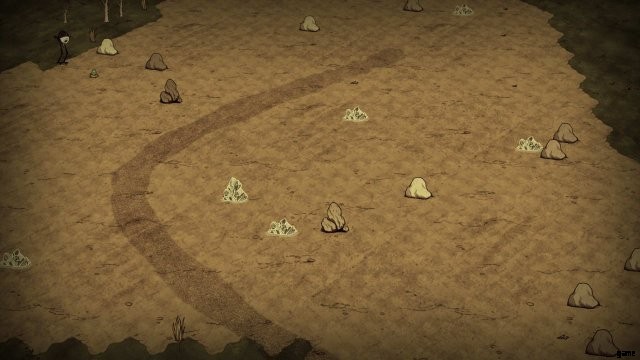
The meteor field is identical to the one found in the Mosaic biome. Nitre-bearing, gold-bearing, moon rock-bearing boulders, and mini glaciers can be found here. Stone-only boulders and additional moon rock-bearing boulders spawn during meteor showers. Tallbird nests can generate here, but not always.
Bee field:
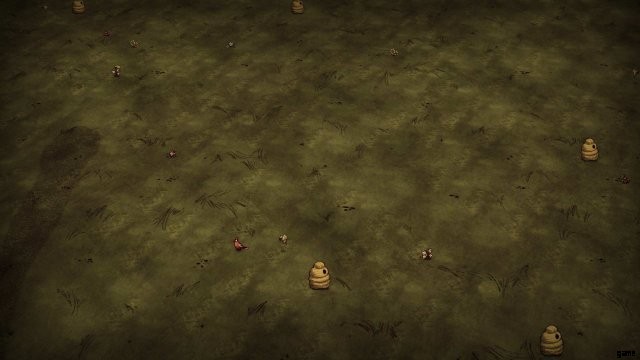
The bee field is identical to the one found in the Bee Queen and Killer Bee biomes. It contains flowers and beehives in a relatively open area. Fireflies can be found here.
Grasslands:
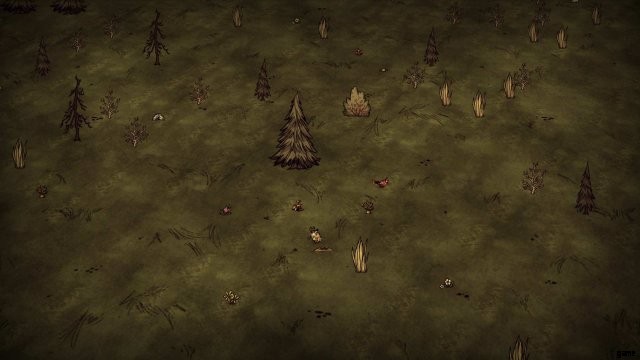
The grasslands is identical to the ones found in the Bee Queen, Killer Bee, and Portal biomes. It contains grass, saplings/twiggy trees, evergreens, birchnut trees, flint, flowers, carrots, all three mushrooms, and berry bushes. Frog ponds and spider dens can generate here, but not always. Rabbit holes and moleworm burrows are found here.
Wormholes and Sinkholes
Wormholes can generate here, but not always. The biome always contains one sinkhole.
Grass Gecko Worlds
In a grass gecko world, all grass tufts are absent from this biome. Grass geckos can be found in the meteor field.
Unique Perks
Meteor showers occur in this biome in exactly the same way as in the Mosaic biome. See the unique perks section for that biome for details.
Resources
- Gras
- Grass Geckos (in a grass gecko world)
- Saplings/Twiggy Trees
- Carrots
- Flowers
- Berry Bushes
- Red, Green, and Blue Mushrooms
- BIrchnut Trees
- Evergreens
- Nitre-bearing Boulders
- Gold-bearing Boulders
- Stone-only Boulders (spawn from meteor showers)
- Moon rock-bearing Boulders (as part of world generation and from meteor showers)
- Mini Glacier
- Rocks
- Flint
- Rabbit Holes
- Moleworm Burrows
- Beehives
- Tallbird Nests
- Fireflies
Distinguishing Features
The Extra Meteors contains a meteor field surrounded by grasslands and a bee field rather than mosaic or forest terrain found in the Mosaic biome.
Frog Ponds
Map view of a Frog Ponds biome:
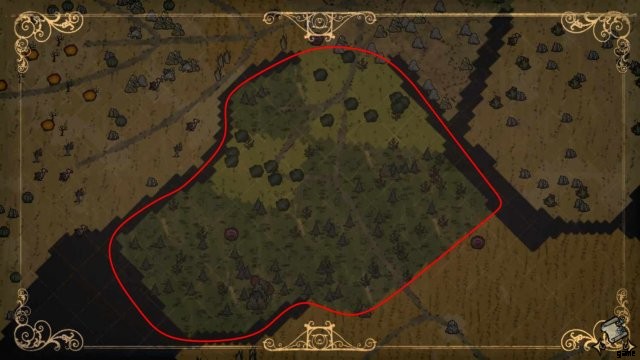
Description
The Frog Ponds is the optional biome that contains a cluster of frog ponds surrounded by sparse forest terrain. The biome consists of two parts:the pond area, and the barren forest.
The pond area:
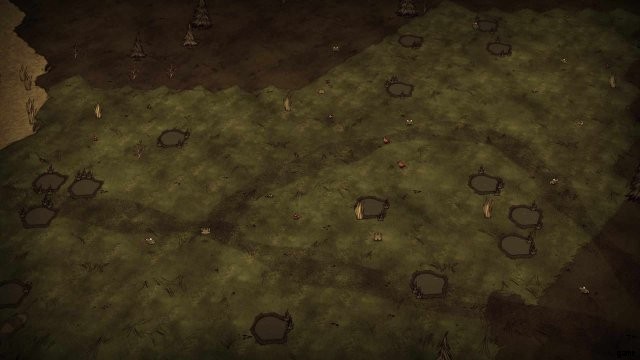
The pond area is covered by grass turf and contains 12-16 frog ponds. Grass, saplings/twiggy trees, and flowers can be found here. Occasionally, the cluster is split into two groups.
The barren forest:

The barren forest area is covered in forest turf, and is sparsely populated by saplings/twiggy trees and evergreens. Grass, red mushrooms, green mushrooms, and berry bushes not part of the moose pond set piece are rare. Beehives and Pig Houses can generate here, but not always. Fireflies are common here. The Stagehand can possibly generate here.
Wormholes and Sinkholes
The biome always contains a wormhole, but the destination is not consistent. In most generated worlds, there is a sinkhole in this biome.
Grass Gecko Worlds
In a grass gecko world, grass does not generate in the entire biome. Grass geckos are not found in this biome.
Resources
- Gras
- Saplings/Twiggy Trees
- Berry Bushes
- Flowers
- Red, and Green Mushrooms
- Evergreens
- Beehives
- Pig Houses
- Frog Ponds
- Fireflies
Distinguishing Features
The Frog Ponds biome has 14-16 frog ponds whereas the pond cluster in the Frogs and Bugs biome has half as many.
Frogs and Bugs
Map view of a Frog and Bugs biome:
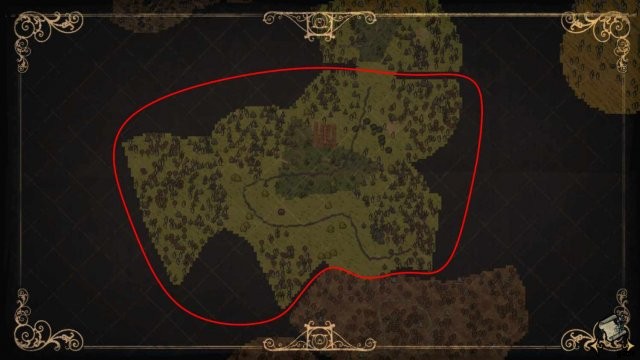
Description
The Frogs and Bugs biome is the optional biome that contains a cluster of frog ponds and a field of beehives. If this biome exists in the world, the Eye Bone and Stagehand are guaranteed to generate here. The biome consists of five parts:ponds, bee field, moleworm field, grasslands, and forest.
The ponds:
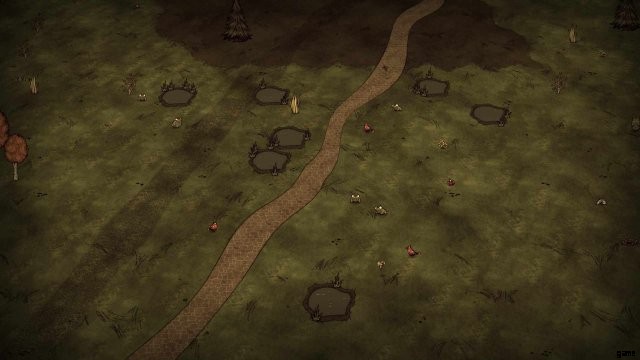
The ponds area contains a cluster of 6-7 frog ponds, and is commonly located along the cobblestone road when a Pig Village biome is absent*. Grass and saplings can be found next to the ponds.
Bee field:
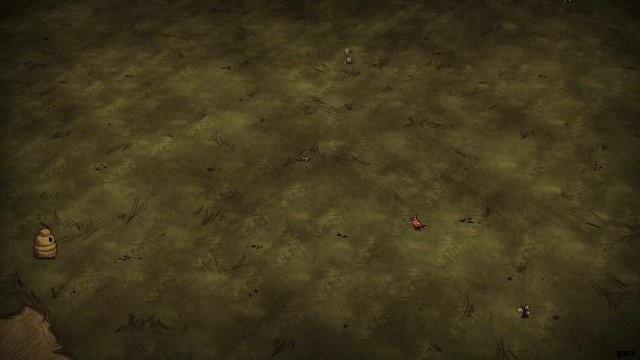
The bee field contains a variably dense to sparse collection of beehives and flowers. Fireflies can be found in this area.
Moleworm field:
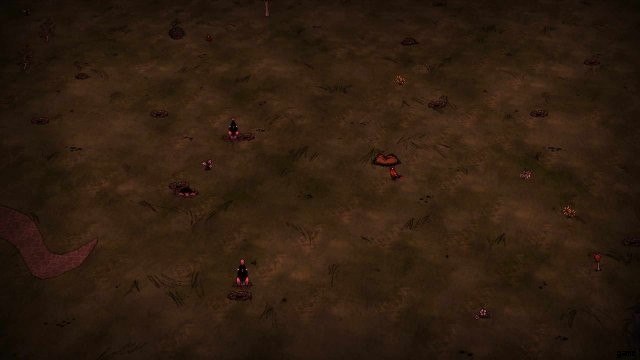
The moleworm field contains moleworm burrows, rocks, flint, and flowers. The Eye Bone can always be found here.
Grasslands:
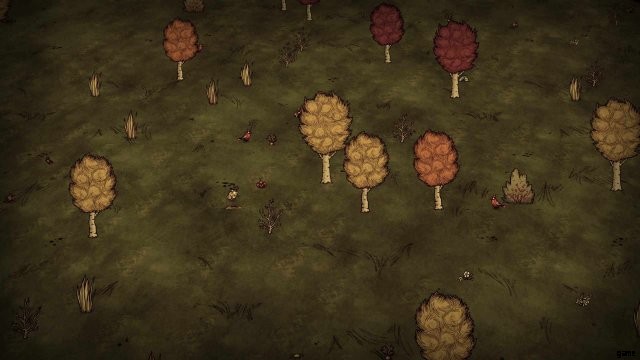
The grasslands is identical to the ones found in the Killer Bee, Portal, and Bee Queen biomes. The area is populated with grass, saplings, berry bushes, birchnut trees, evergreens, carrots, flowers, flint, and all three mushrooms. Rabbit holes, moleworm burrows, and frog ponds can be found here. Spider dens can generate here, but not always.
Forest:
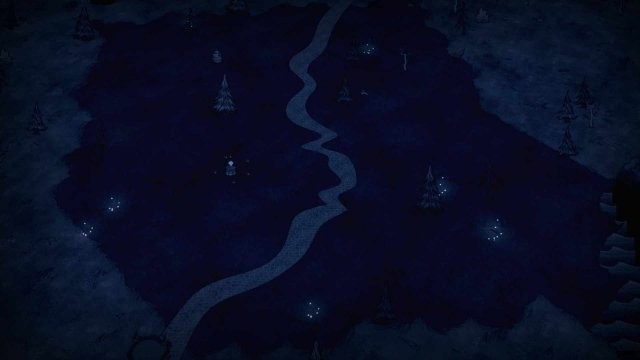
The forest contains a sparse arrangement of evergreens, and saplings/twiggy trees. Berry bushes and beehives can generate here, but not always. Fireflies can be found in this area. The Stagehand can always be found here.
Wormholes and Sinkholes
Wormholes can generate here, but not always. The biome always comes with one sinkhole.
Grass Gecko Worlds
In a grass gecko world, grass is absent from the entire biome. Grass geckos do not generate here.
Unique Perks
The Eye Bone and Stagehand always generate in this biome when it is present.
Resources
- Gras
- Saplings/Twiggy Trees
- Berry Bushes
- Carrots
- Flowers
- Red, green, and blue mushrooms
- Rocks
- Flint
- Evergreens
- Birchnut Trees
- Ponds
- Rabbit Holes
- Moleworm Burrows
- Spider Dens
- Beehives
- Fireflies
- Eye Bone
- Stagehand
Distinguishing Features
The Frogs and Bugs biome is similar to the Frog Ponds biome, but contains a grasslands area. The pond cluster in the Frog Ponds biome generates up to 14 ponds, whereas the one in the Frogs and Bugs only generates half as many.
Killer Bee
Map view of a killer bee biome:
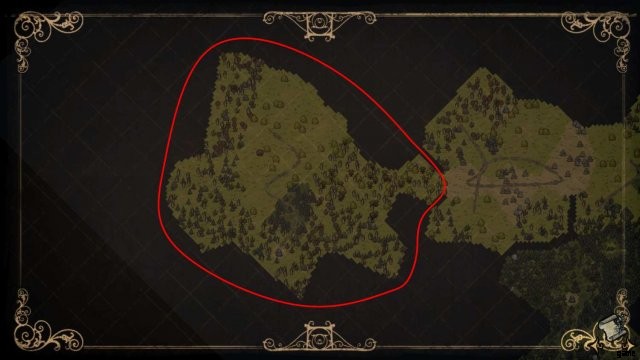
Description
The Killer Bee biome is the optional biome that contains the largest amount of killer bee and bee hives. The biome consists of three main parts:killer bee field, open bee field, grasslands, and forest.
Killer Bee field:
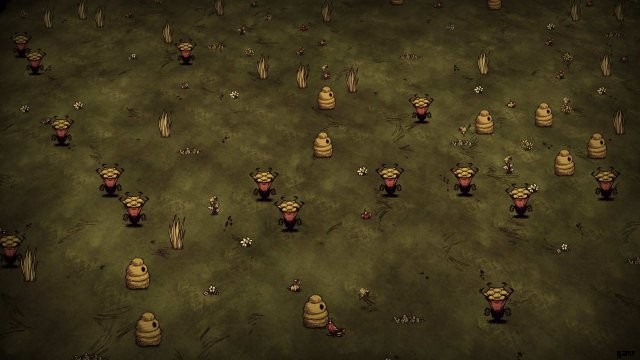
The killer bee field is densely packed with beehives, killer bee hives, flowers, and grass. This area is always located at the “entrance” to the biome.
Open bee field:
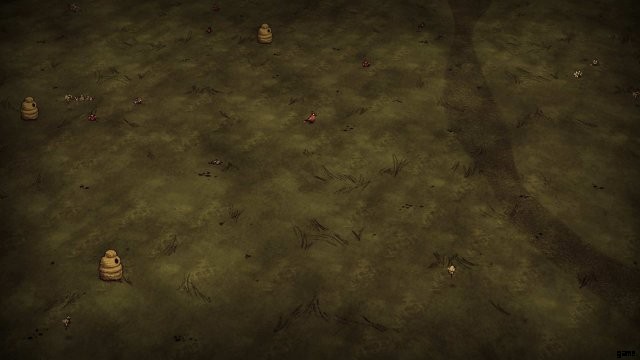
The open bee field contains a sparse arrangement of beehives and flowers. Fireflies can be found here. There is a chance of finding the Eye Bone and Stagehand together in this area.
Grasslands:
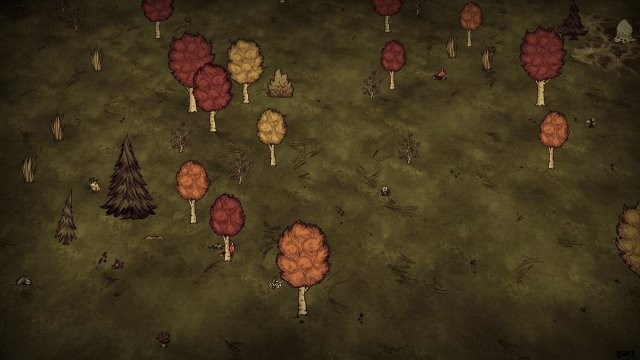
The grasslands is covered by grass turf, and is populated by resources identical to those found in the Portal biome’s grasslands. Grass tufts, saplings/twiggy trees, berry bushes, carrots, flowers, flint, all three mushroom types, birchnut trees, and evergreens can be found here. Beehives and spider dens can generate here, but not always. Rabbit holes, moleworm burrows, and frog ponds can be found here.
Forest:
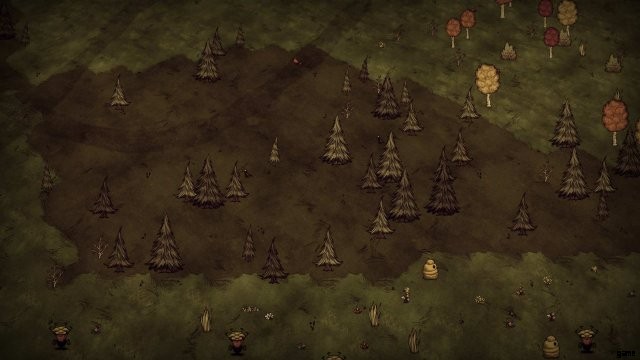
The forest area is covered by forest turf, and contains evergreens, saplings/twiggy trees, and fireflies. Berry bushes and nitre-bearing boulders are rarely found here.
Wormholes and Sinkholes
Wormholes can generate here, but not always. The biome will always generate with a single sinkhole.
Grass Gecko Worlds
In a grass gecko world, grass will be missing from the entire biome. Grass geckos do not generate here.
Resources
- Gras
- Saplings/Twiggy Trees
- Evergreens
- Birchnut Trees
- Flowers
- Carrots
- Flint
- Red, green, and blue mushrooms
- Beehives
- Killer Bee Hives
- Rabbit Holes
- Moleworm Burrows
- Fireflies
Distinguishing Features
The Killer Bee Biome is the only other biome to generate with killer bee biomes apart from the Bee Queen. The most obvious giveaway is the large number of killer bee hives upon entering the biome, but wormhole travelers ending up in the grasslands or forest area may not recognize the biome right away.
Pig Village Forest
Map view of a Pig Village biome:
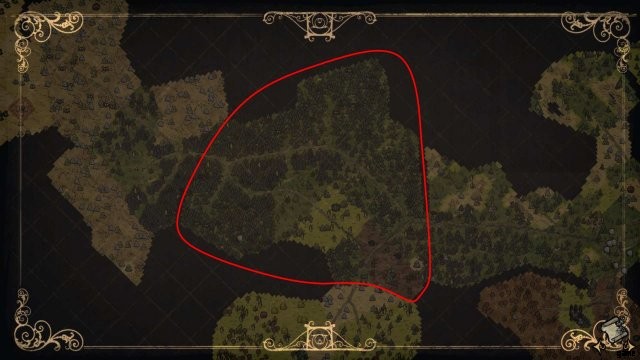
Description
The Pig Village biome is the one that contains a pig village and swamp terrain in a forest environment. The biome contains the evergreen forest, dense forest, and less dense forest found in the Mandrake Forest biome. Three additional areas generate here:pig village, mini swamp, firefly field.
Pig Village:
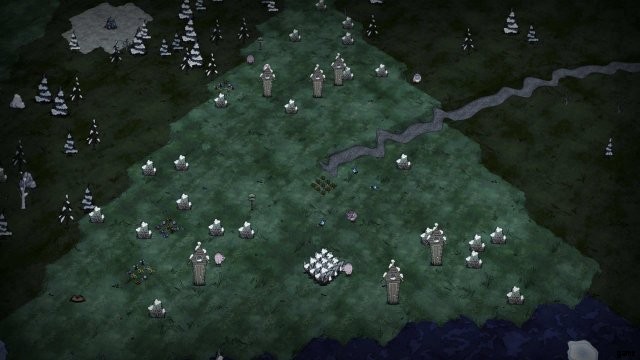
The Pig Village is a collection of Pig Houses, berry bushes, and sets of 9 of any of the following:carrots, flowers, grass, and berry bushes. This is the only location where merm heads can generate.
Mini swamp:
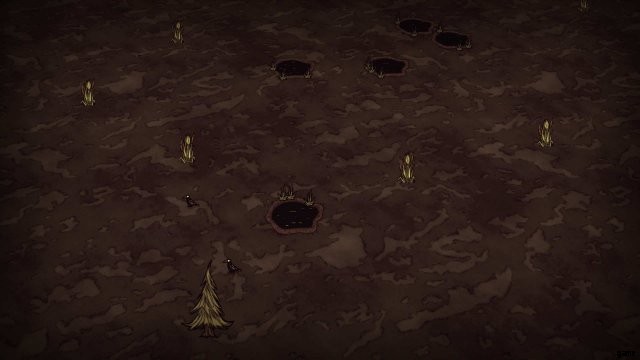
The mini swamp is identical to the reed field found in the swamp biome. This area consists only of reeds, mosquito-bearing ponds, tentacles, and evergreen trees. The Eye Bone has a chance of appearing here.
Firefly field:
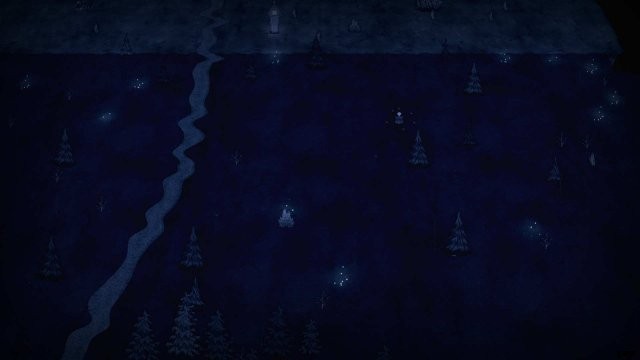
This area commonly generates adjacent to the pig village, and contains a sparse collection of evergreens, saplings, grass, and berry bushes. Pig houses and/or beehives can generate here, but neither are guaranteed to do so. This area is rich in fireflies.
Wormholes and Sinkholes
Both wormholes and sinkholes can generate here, but neither are guaranteed to do so.
Grass Gecko Worlds
In a grass gecko world, grass will be absent from the entire biome. Grass geckos do not generate in this biome.
Resources
- Gras
- Saplings/Twiggy Trees
- Berry Bushes
- Reeds
- Flowers
- Carrots
- Evergreens
- Lumpy Evergreens
- Totally Normal Trees
- Evil Flowers
- Red, Green, and Blue Mushrooms
- Spider Dens
- Pig Houses
- Graves
- Frog Ponds
- Mosquito Ponds
- Tentacles
- Fireflies
Location
The Pig Village is always linked with the Pig King biome via the cobblestone road. A consequence of this linkage is that the road will pass through biomes that it would otherwise never be in, such as the Portal, Mosaic, or Savanna.
The pig village connected to the pig king by cobblestone road (dark line):
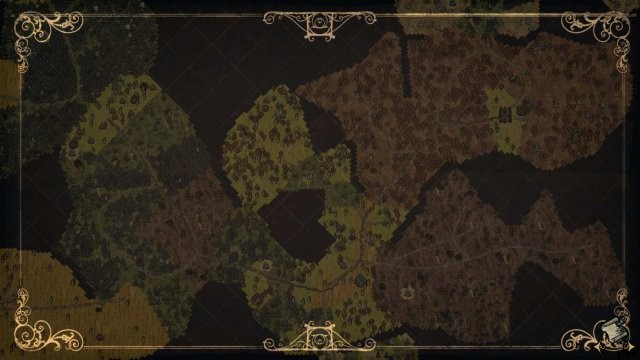
Distinguishing Features
The Pig Village is the only other biome apart from the Swamp to contain marsh terrain with reeds and mosquito-bearing ponds. Spiky trees and bushes on marsh turf are only found in the Swamp biome. The Pig Village is very similar to the Mandrake Forest and Moon Forest biomes. The Moon Forest can be identified by the presence of moleworm burrows, whereas the Mandrake Forest can be identified by the savanna turf.
Quad Moose Eggs
Map view of a Quad Moose Eggs biome:

Description
The quad moose eggs biome is the one containing four moose nests that are not part of the moose pond set piece. The biome is entirely composed of grassland terrain, and can generate adjacent to other biomes that contain the same terrain. As a result, the biome can be difficult to identify on the map.
The Quad Moose Eggs biome with the moose nests marked:
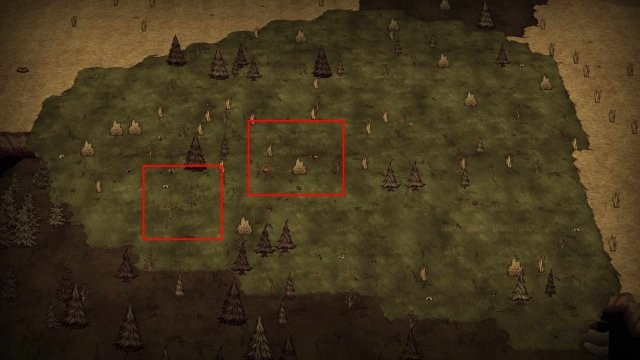
The biome is relatively small and only consists of grassland terrain similar to those found in the Portal, Bee Queen, Killer Bee, Frogs and Bugs, and Extra Meteors biomes. The terrain consists of the usual grass, saplings/twiggy trees, carrots, flowers, birchnut trees, evergreens, and flint. Berry bushes are slightly more common here. Only blue mushrooms have been observed here, and they do not always generate. The same applies to moleworm burrows, and frog ponds not part of the moose pond set piece.
Wormholes and Sinkholes
No wormholes or sinkholes have been observed in this biome.
Grass Gecko Worlds
In a grass gecko world, all grass is absent from this biome, and grass geckos do not generate here.
Unique Perks
The Quad Moose Eggs biome is the only one where moose nests exist outside of the more common moose pond set piece.
Resources
- Gras
- Saplings
- Birchnut Trees
- Evergreens
- Carrots
- Flowers
- Blue Mushrooms
- Moleworm Burrows
- Frog Ponds
- Moose Nests
Distinguishing Features
The Quad Moose Eggs biome can only be reliably identified off the map by the presence of moose nests not attached to frog ponds. In more obvious cases, the biome appears as a patch of grassland terrain within or next to biomes that do not contain such terrain.
Rockylands
A typical rockylands biome:
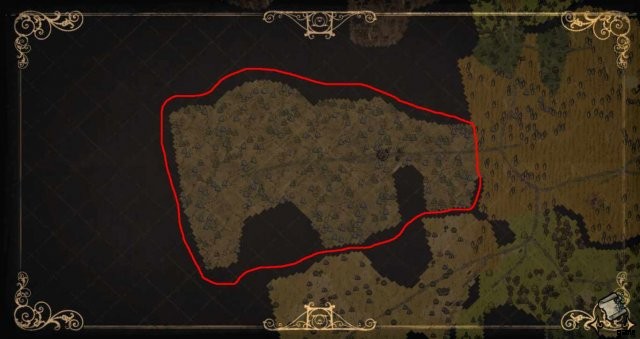
Description
The rockylands biome is a commonly terminal biome consisting of all rocky turf.
The rocky terrain:
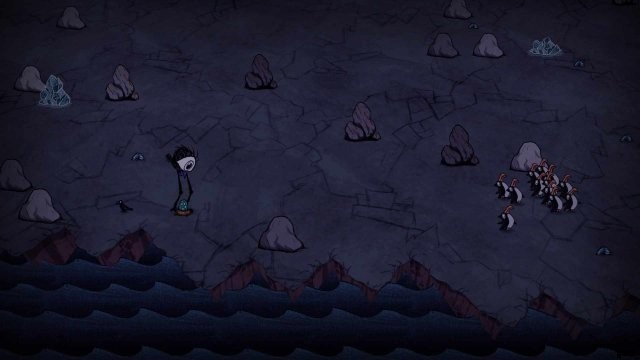
The biome contains a homogeneous spread of mini glaciers, nitre-bearing boulders and gold-bearing boulders. Rocks and flint can be readily found on the ground. Buzzard spawns commonly generate here but are not guaranteed to do so.

Tallbird nests can spawn here either individually or as part of the tallbird fortress set piece, but neither are guaranteed to generate. Hound mounds can generate here only as part of the hound fortress set piece. The marble sculpture set piece that always generates in a world has a chance of generating in this biome.
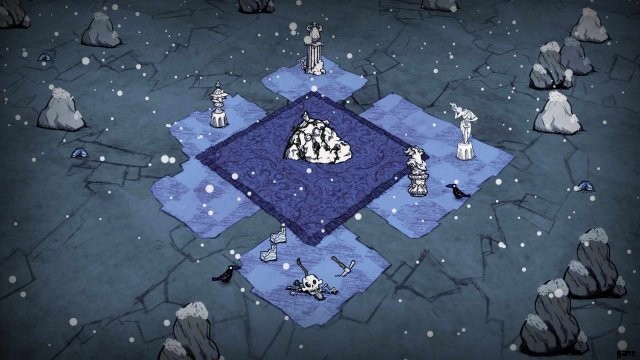
Grass Gecko Worlds
In a grass gecko world, geckos will generate here.
Wormholes and Sinkholes
Both wormholes and sinkholes have not been observed in this biome.
Resources
- Rocks
- Flint
- Nitre-bearing Boulders
- Gold-bearing Boulders
- Mini Glaciers
- Tallbird Nests
- Buzzards
Optional Set Pieces
- Tallbird Fortress
- Hound Fortress
Distinguishing Features
The biome is unique in that it features buzzard spawns over rocky turf. The only two biomes with extensive rocky turf, the Spider Quarry and Triple MacTusk, can also be quickly identified via other features. If there are lumpy tree forests or spiders, it’s a Spider Quarry. If there are MacTusk camps and grasslands, it’s a Triple MacTusk. Sinkholes and wormholes do not generate in the rockylands biome, so encountering one indicates either a Triple MacTusk or Spider Quarry.
Spider Quarry
Map view of a spider quarry:

Description
The spider quarry is the biome that contains a group of spider dens on rocky turf. The biome consists of three main parts:lumpy evergreen forest, evergreen forest, spider field, and rocky field.
Lumpy evergreen forest:
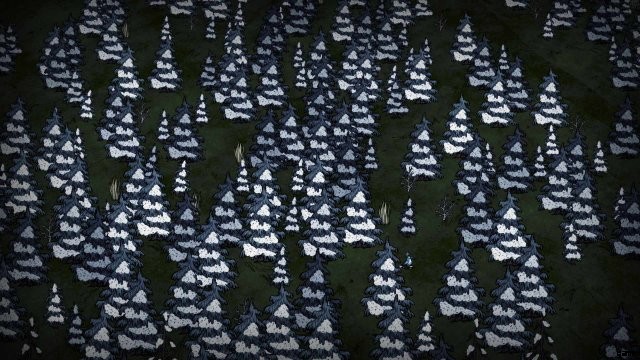
The lumpy evergreen forest consists of a dense collection of lumpy evergreens. Saplings/twiggy trees are common while grass is less so. Berry bushes, green mushrooms, and pig houses can generate here, but not always. Fireflies can be found here.
Evergreen forest:
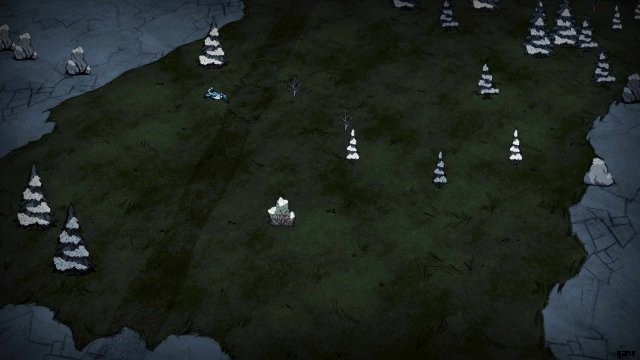
The evergreen forest contains a sparse collection of evergreens, saplings, and berry bushes. Fireflies are present here.
Spider field:
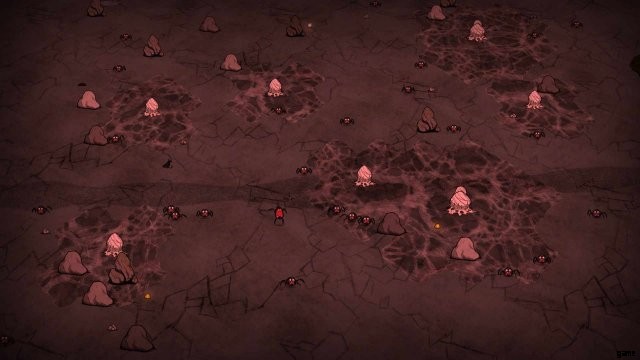
The spider field consists of a cluster of spider dens within a field of rocks, gold, nitre-bearing boulders, and gold-bearing boulders.
Rocky field:

The rocky field contains flint, nitre-bearing boulders, gold-bearing boulders, and mini glaciers. Tallbird nests can generate here, but not always.
Wormholes and Sinkholes
Wormholes can generate here, but not always.
Grass Gecko Worlds
In a grass gecko world, grass is absent from the entire biome. Grass geckos generate in the rocky field.
Resources
- Gras
- Saplings/Twiggy Trees
- Berry Bushes
- Green Mushrooms
- Evergreens
- Lumpy Evergreens
- Rocks
- Flint
- Gold
- Nitre-bearing Boulders
- Gold-bearing Boulders
- Mini Glaciers
- Pig Houses
- Fireflies
Distinguishing Features
The Spider Quarry, Rockylands, and Triple MacTusk biomes all contain rocky terrain populated by nitre-bearing and gold-bearing boulders. However, there are features of the rocky terrain that are unique to each biome:
- The Spider Quarry has spider dens over rocky turf.
- The Rockylands has buzzards over rocky turf.
- The Triple MacTusk has a walrus camp over rocky turf.
Rocks and flint generate throughout the Rockylands biome, but rocks are only found in the spider field in the Spider Quarry.
Triple MacTusk
Map view of a Triple MacTusk biome:
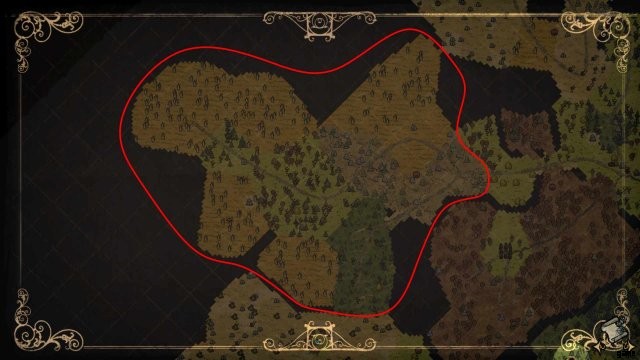
Description
The Triple MacTusk biome is the optional biome that contains three walrus camps. The biome consists of four distinct areas:the savanna, grasslands, rocky area, and barren forest. The first three are each home to a single walrus camp.
The savanna area:
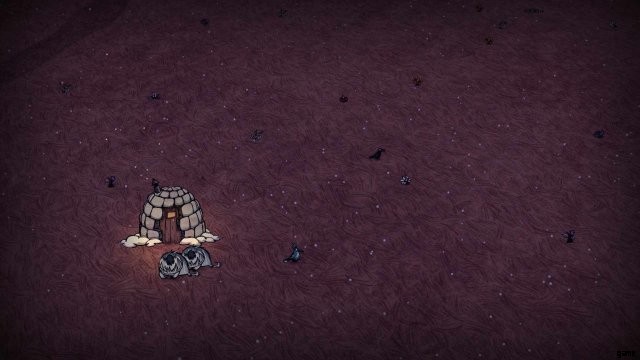
The savanna contains abundant grass and rabbit holes. Spider dens are common here. Flowers can be found here, and occasionally a flower-rich area generates.
Grasslands:
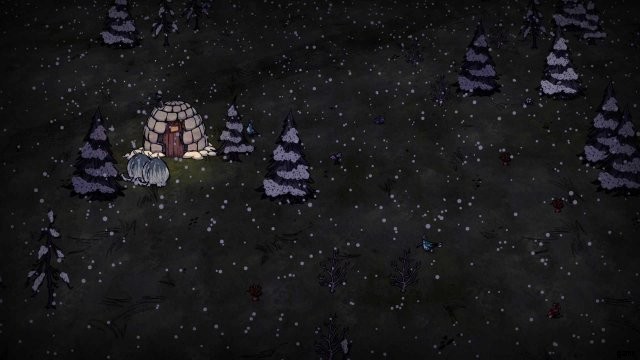
The grasslands contains grass, saplings/twiggy trees, berry bushes, flint, evergreens, birchnut trees, carrots, and flowers. Blue mushrooms, frog ponds, moleworm burrows, and rabbit holes can generate here, but none are guaranteed to do so.
Rocky area:
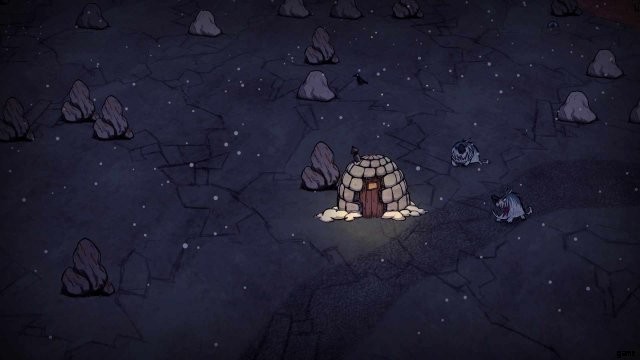
The rocky area consists of nitre-bearing boulders, gold-bearing boulders, and mini glaciers. Flint is readily available here. Tallbird nests can generate here, but are not guaranteed to do so.
Barren forest:
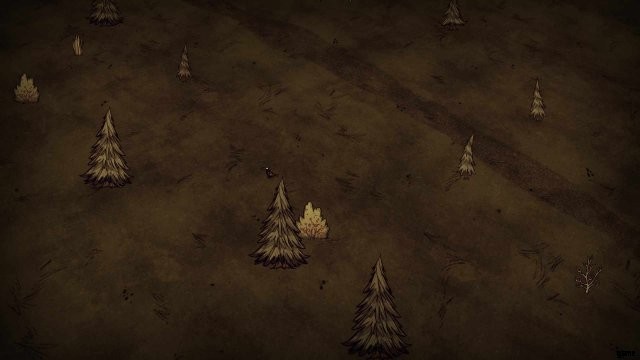
The barren forest consists of a sparse collection of evergreens, and saplings/twiggy trees. Berry bushes and grass are rare. Red mushrooms can be found here, but they rarely generate. Fireflies can only be found in this area of the biome. Pig houses rarely generate in this area.
Wormholes and Sinkholes
Both wormholes and sinkholes can generate in this biome, but neither are guaranteed to do so.
Grass Gecko Worlds
In a grass gecko world, grass can only be found in the savanna area. If the flower-rich area in the savanna generates, all the grass will be absent there. Grass Geckos generate in the rocky area.
Resources
- Gras
- Saplings/Twiggy Trees
- Berry Bushes
- Carrots
- Flowers
- Red Mushrooms
- Flint
- Evergreens
- Nitre-bearing Boulders
- Gold-Bearing Boulders
- Walrus Camps
- Spider Dens
- Rabbit Holes
- Pig Houses
- Frog Ponds
Distinguishing Features
The Triple MacTusk can easily be identified by walrus camps on rocky and savanna turf. The walrus camp in the Moon Forest only generates on grassy turf. The rocky terrain does not contain rocks, whereas the Rockylands biome does. Spider nests only generate on rocky terrain in the Spider Quarry.
Appendix
About Birds
Since I list resources in every biome, birds deserve special treatment. Their availability is dependent on the turf that is present. Since turfs can be moved around and replaced, it is not reliable to assign birds to specific biomes. Therefore, I give a quick explanation about birds here. Buzzards are an exception as they are tied to actual spawners which generate in specific biomes, so they won’t be discussed here.
There are four types of bird:Crow, Redbird, Snowbird, and the Canary. Bird spawn behavior is based on the turf present:
- Crows/Canaries:every turf except grass
- Redbirds/Bluebirds:grass, forest, savanna
Canaries replace crows within a 3 turf radius around a Friendly Scarecrow. No canaries will spawn if the area around the scarecrow is purely grass turf. Redbirds spawn during autumn, spring, and summer, and are replaced by snowbirds during winter.
Removing turfs and replacing them will affect bird spawn behavior, so if you wish to see Redbirds spawn in a Rockylands biome for example, simply place down any of the above three turfs they spawn on. Conversely, if you want to restrict spawns to only crows, simply remove them. One exception:if there are seeds lying just outside valid turfs for the two seasonal birds, they can spawn on the turfs they normally cannot.
On a clear day, a single bird spawns every 5-15 seconds. Equipping a feather hat increases the bird cap from 4 to 7, and birds spawn every 2-10 seconds. During rain, birds spawn 4 times as frequent while snow does not affect the spawn rate.
- No Feather Hat:No Rain 5-15s / Rain 1.25-3.75s / Max Birds – 4
- Feather Hat:No Rain 2-10s / Rain 0.5-2.5s / Max Birds – 7
Clockworks
There are 11 set pieces which generate with clockworks. Each world generates 1-5 of these at random locations.
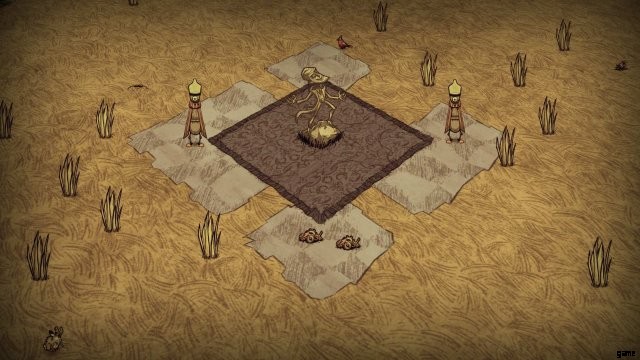
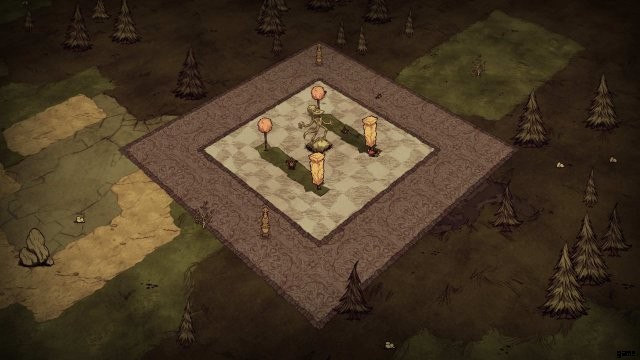
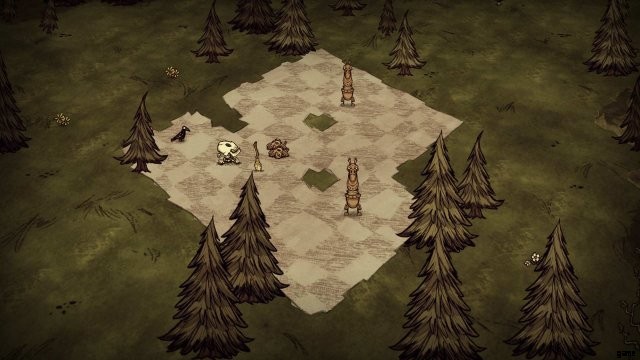
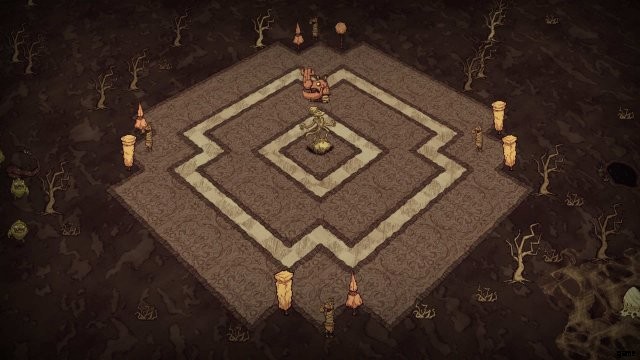


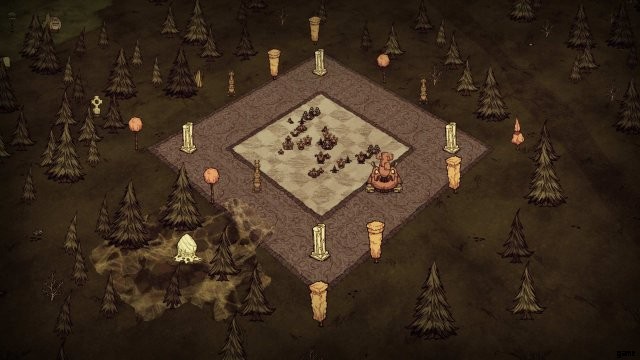
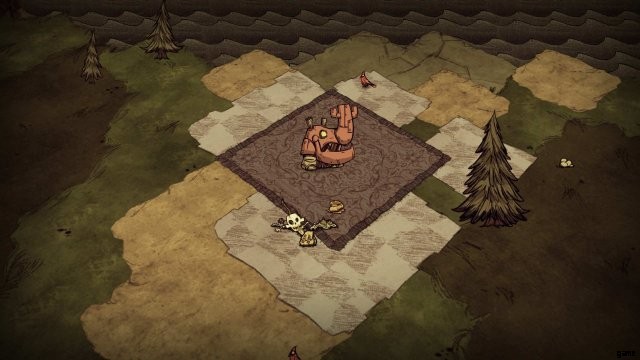
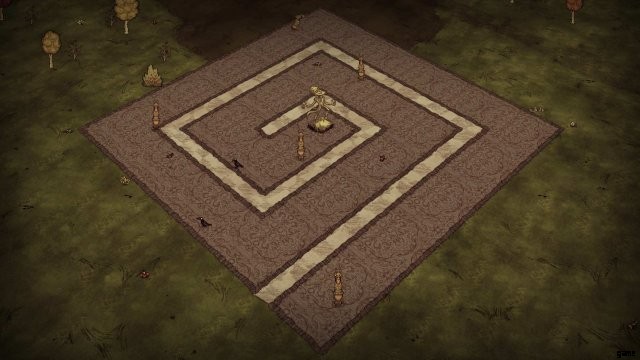
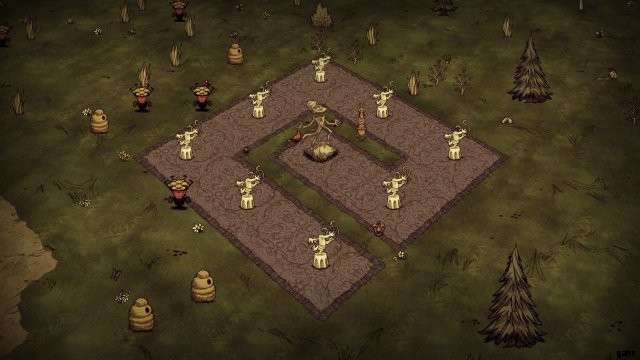
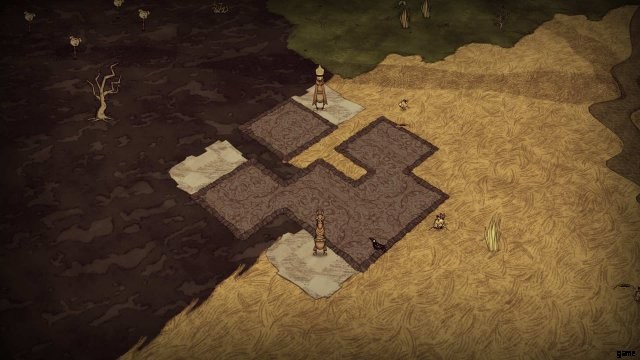
There are also two variants which do not generate with any clockworks.
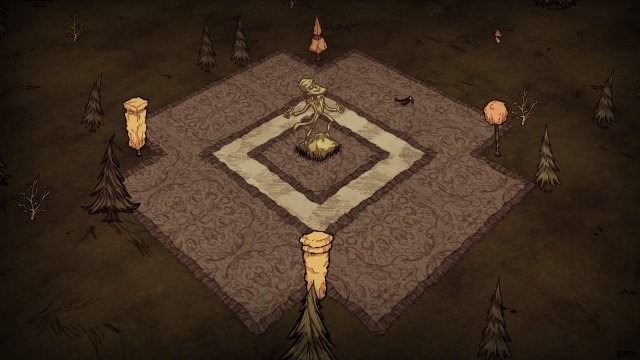

The Eye Bone and Stagehand
The Eye Bone can only be found in the optional biomes. If the Pig Village biome is not present in the world, the Eye Bone will be found near the cobblestone road. If the Frogs and Ponds biome is present in the world, the Eye Bone will always generate in that biome in the moleworm field.
Stagehand is commonly found near the Eye Bone, but is not guaranteed to do so. Like the Eye Bone, if the Frogs and Bugs biome is present, the Stagehand will always generate there. Otherwise, if the biome where the Eye Bone generates contains grassy or forest turf, the Stagehand will always generate near the Eye Bone. If the Eye Bone generates in a biome that lacks either of these turfs, Stagehand will opt for generation in a biome that does contain them, and includes guaranteed biomes, such as the savanna.
Intersecting Biomes
Swamp biome intersecting a Savanna:
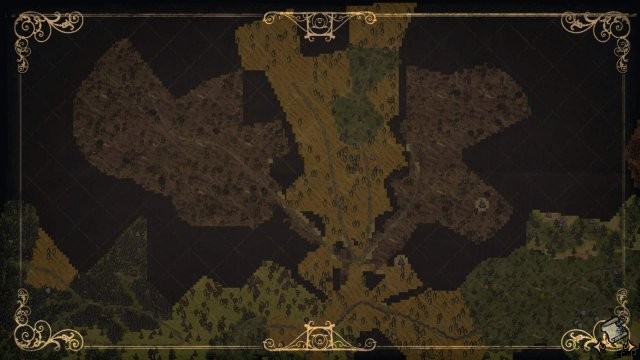
Occasionally, biomes generate in such a way where the intersect with each other. This allows for certain biomes to be abnormally close to the Portal biome, such as the Pig King biome.
Sometimes world generation can be especially messy:
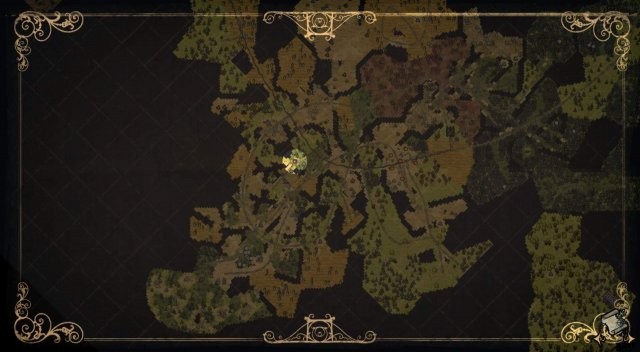
Loot Stash
The Loot Stash appears every winter after the No-Eyed Deer grow their antlers, which typically occurs one to two days after the start of winter. The earliest day that the Loot Stash can appear on is Day 22.
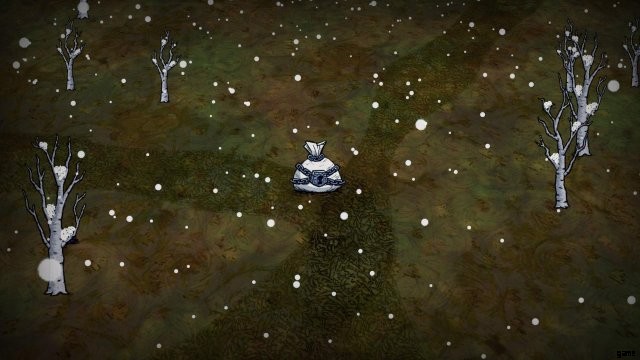
A single Loot Stash appears in the world at three possible biomes:
- Mosaic – in the mosaic terrain
- Pig King – in the forest
- Extra Deciduous – in the forest
The No-Eyed Deer and the Loot Stash do not necessarily appear in the same biome. During the Winter’s Feast Event, the Loot Stash and No-Eyed Deer are available all year round. The Loot Stash does not necessarily respawn in the same biome. For information about how to open the Loot Stash, consult the Don’t Starve Wiki.
Marble Sculptures
There are a variety of set pieces containing marble sculptures, which are required to gain access to Shadow Pieces. The one variant that contains one of each piece (rook, knight, and bishop), and a skeleton boon with 2 marbles and a pickaxe always generates once in the world:
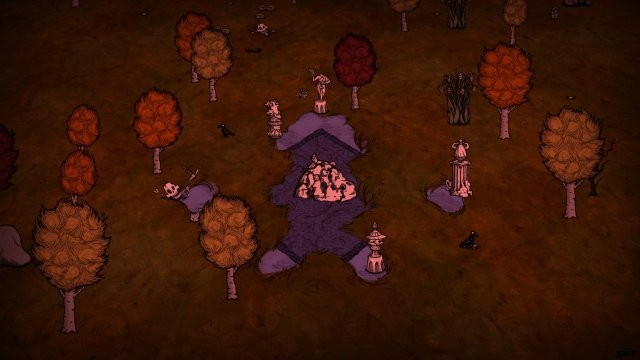
This variant is restricted to certain biomes:
- Bee Queen
- Mandrake Forest
- Pig King
- Rockylands
- Frog Ponds
There are four other variants, which are all optional and contain different arrangements of pieces. Some contain multiple copies of each piece. Unlike the guaranteed variant, these set pieces can be found in any biome. Below are examples of optional marble sculpture set pieces.
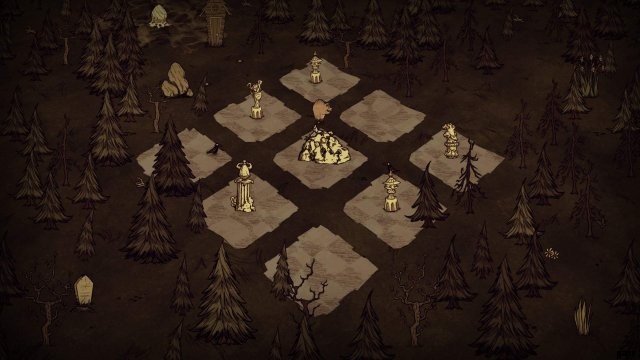

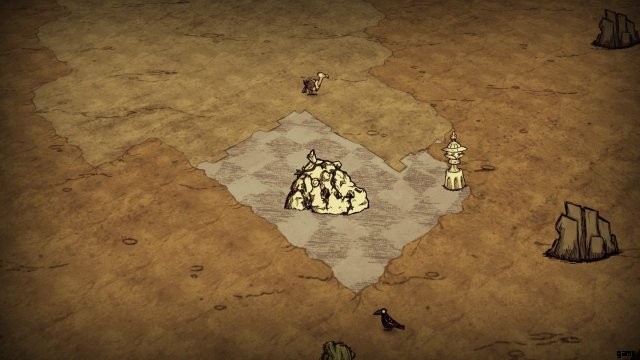
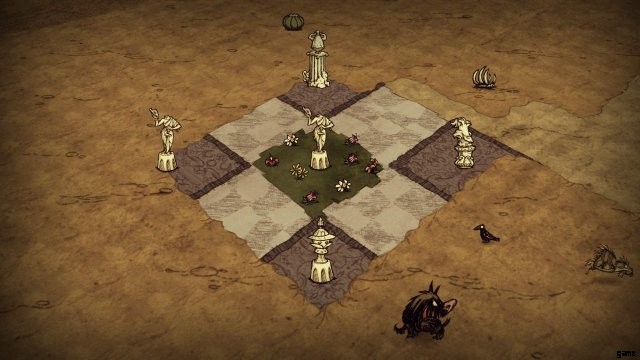
Moose Pond Set Piece
The moose pond set piece consists of a single frog pond surrounded by birchnut/evergreens, 5 berry bushes or 3 juicy berry bushes, 3 carrots, and a single moose/goose nest.
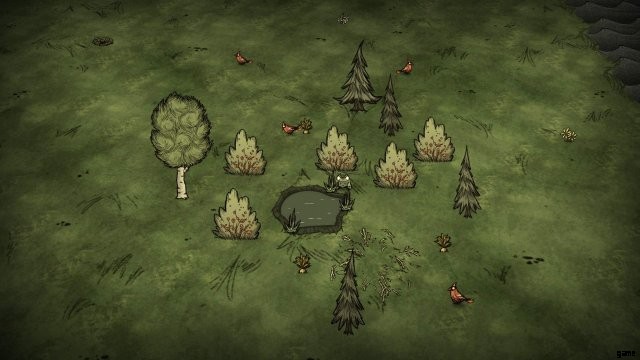
A single moose pond set piece consistently generates in each of the following biomes:
- Bee Queen
- Mandrake Forest
- Moon Forest
- Pig King
- Portal
- Extra Meteor Zone
- Frog Ponds
- Frogs and Bugs
- Pig Village
This allows for a maximum of 13 moose nests in a single world (9 from moose ponds, and 4 from the Quad Moose Eggs biome).
